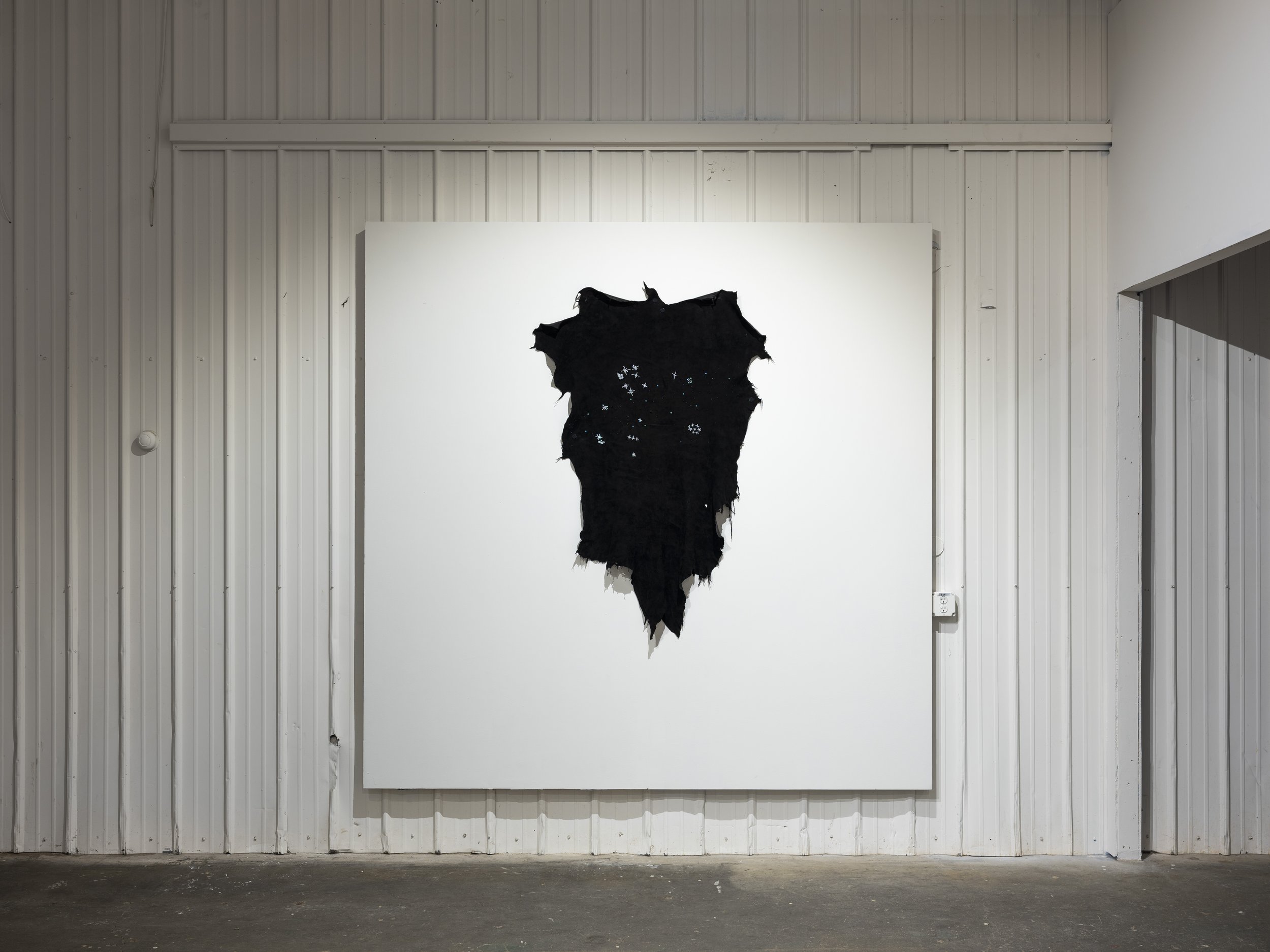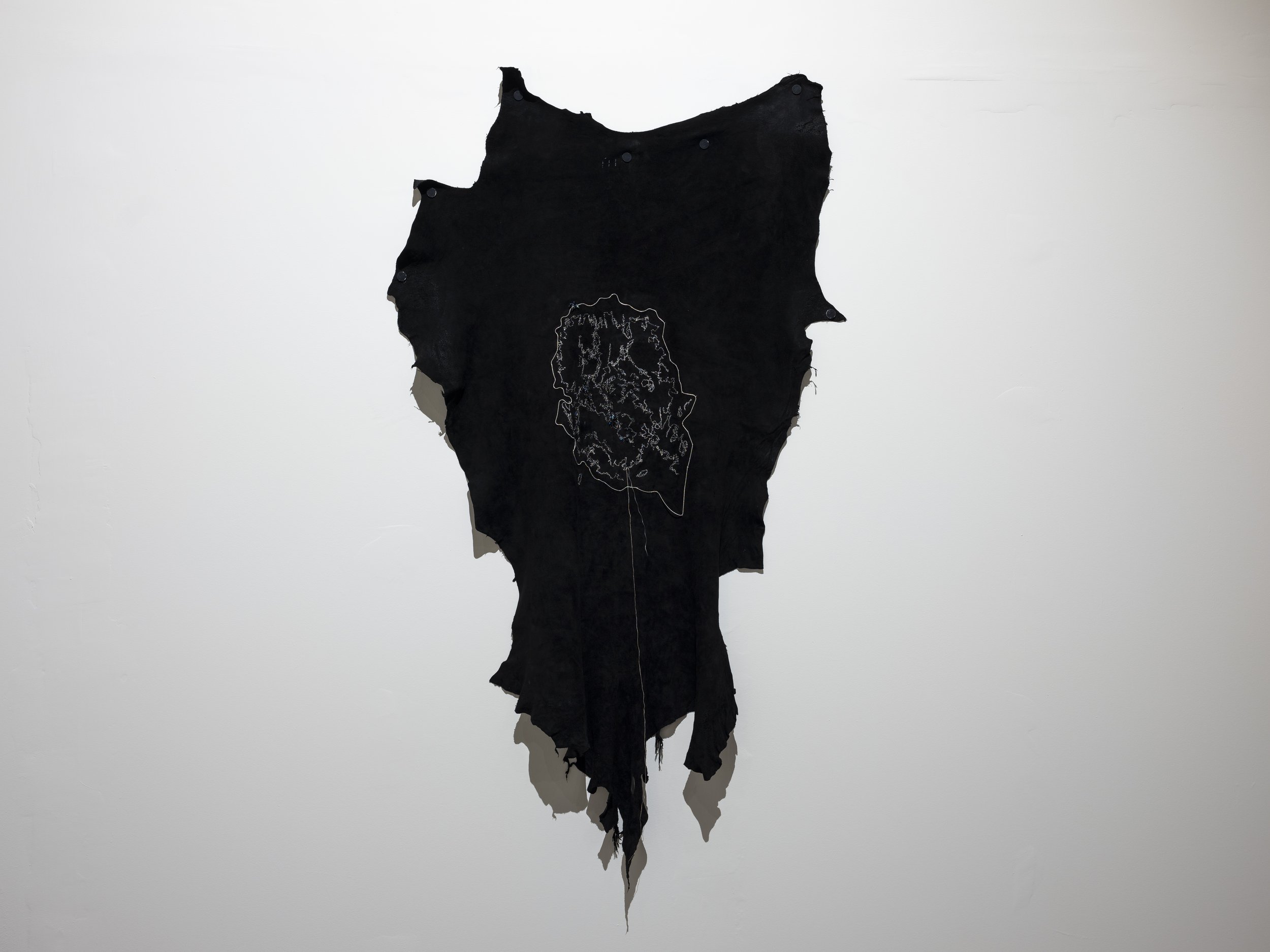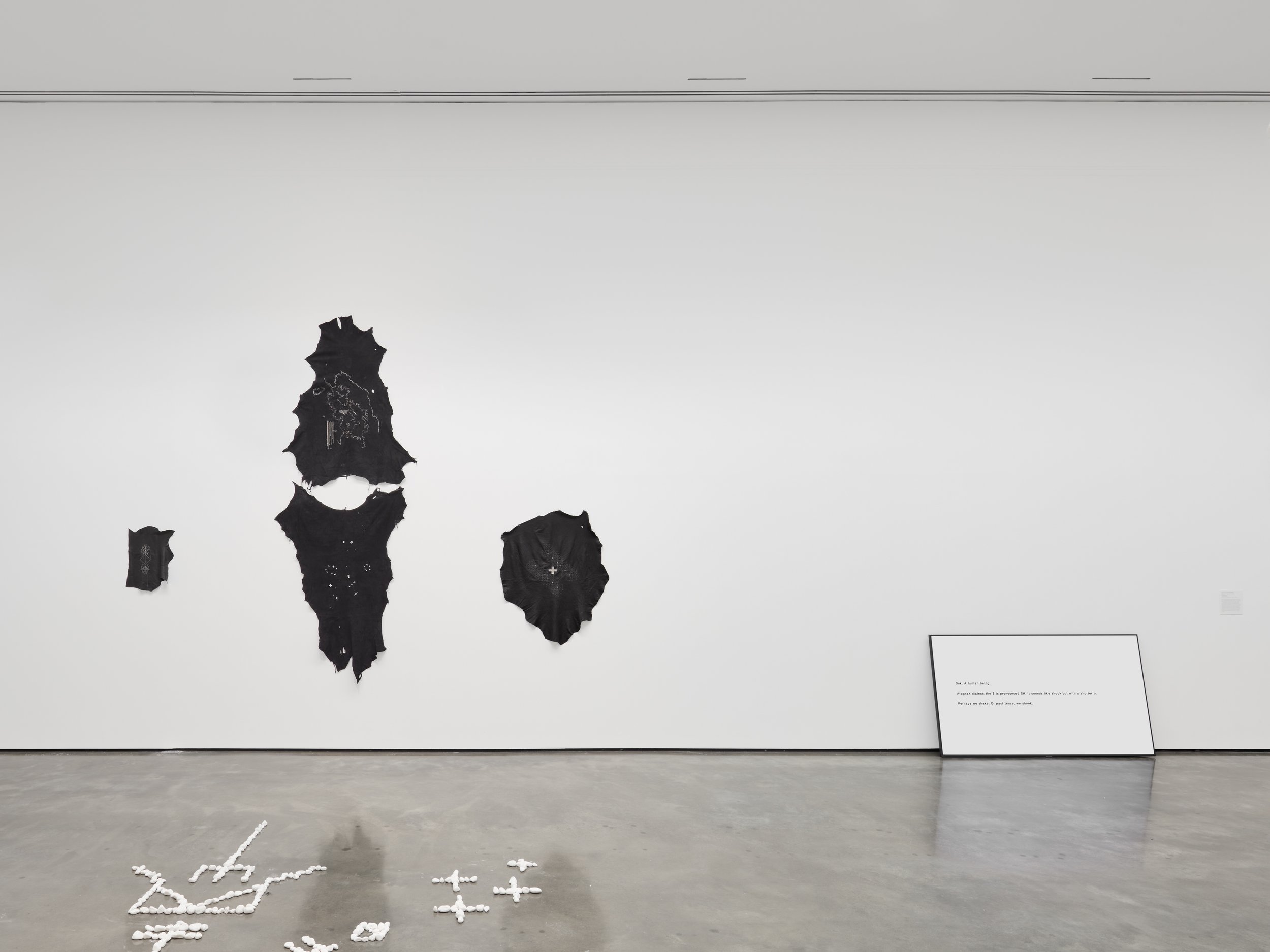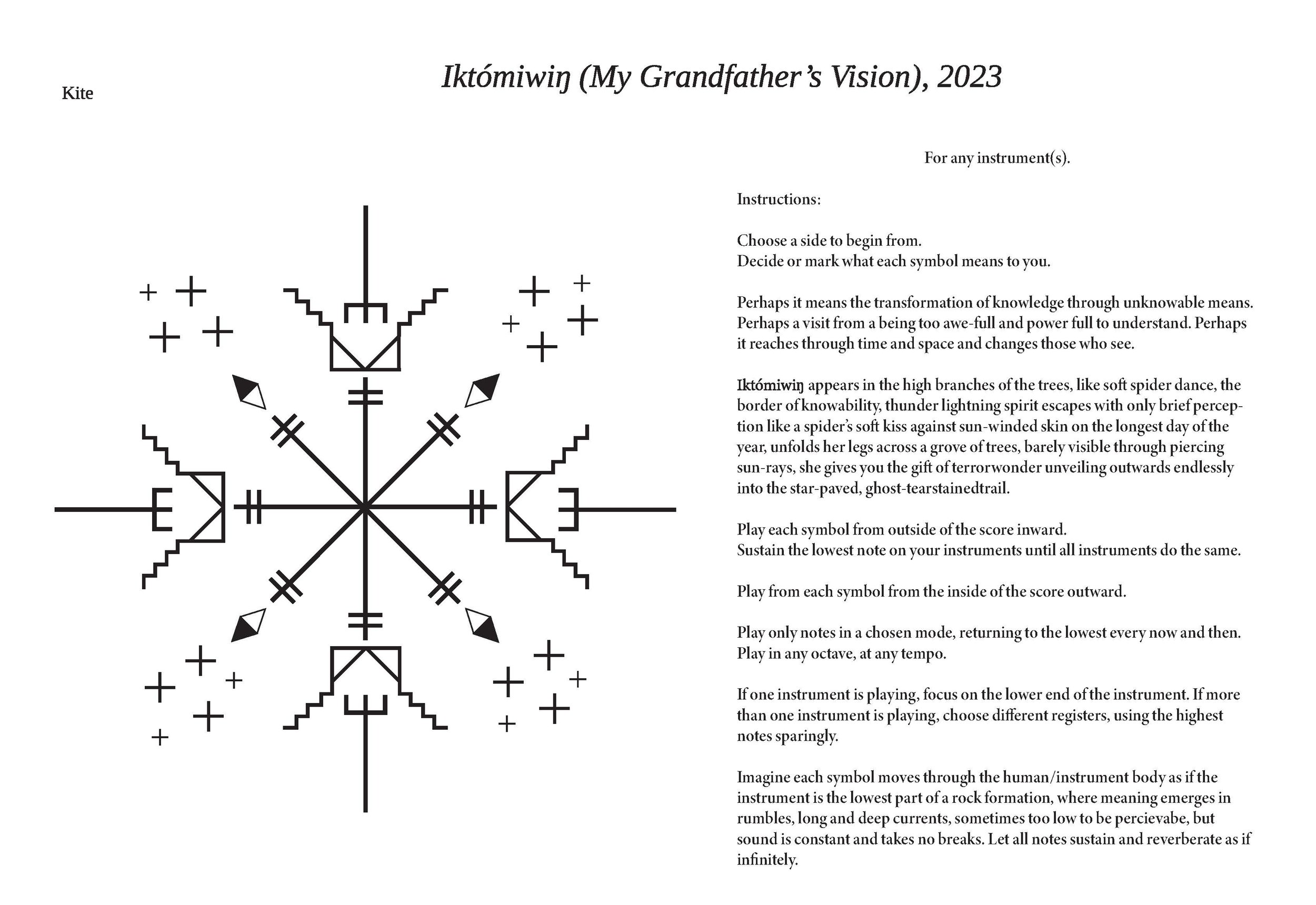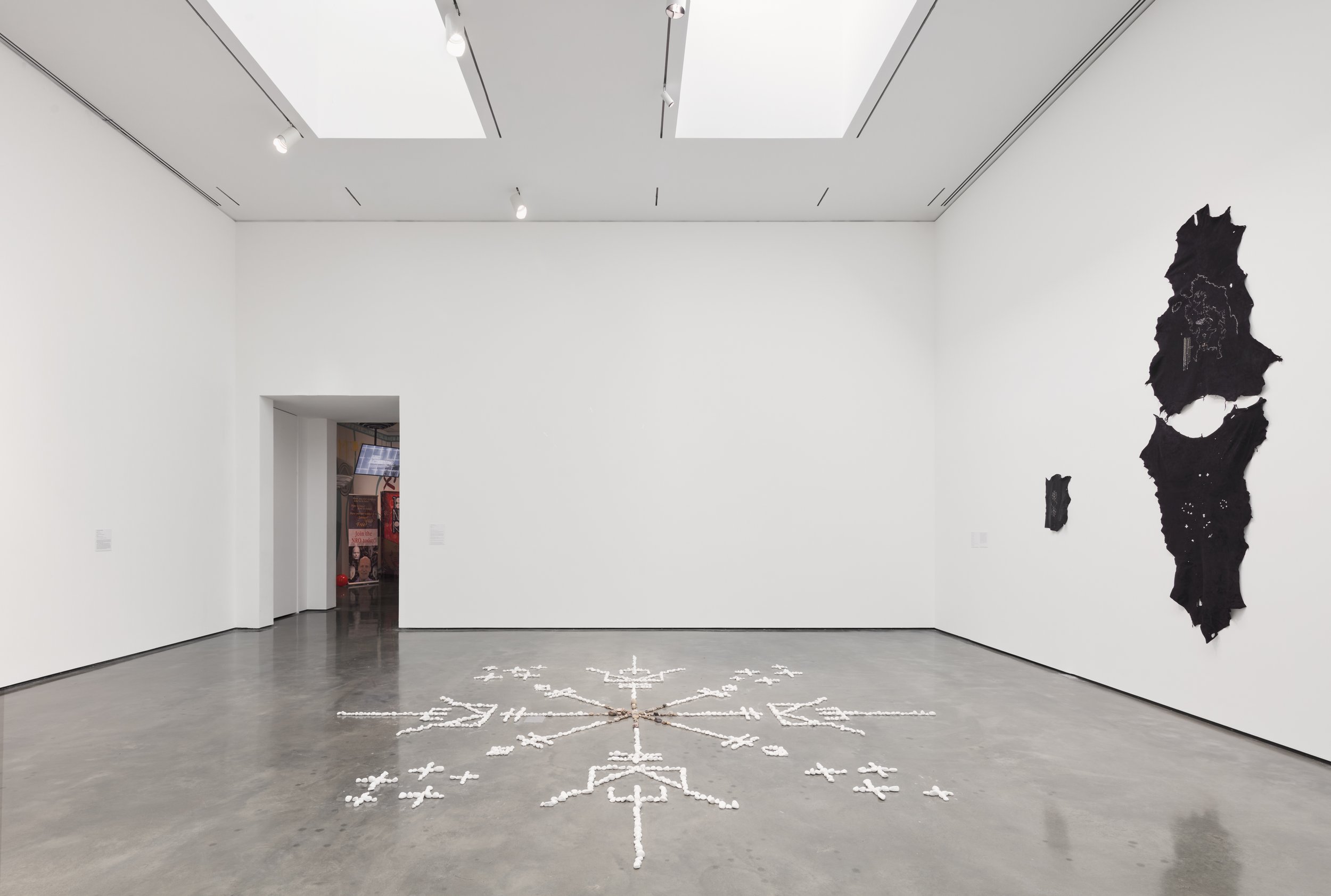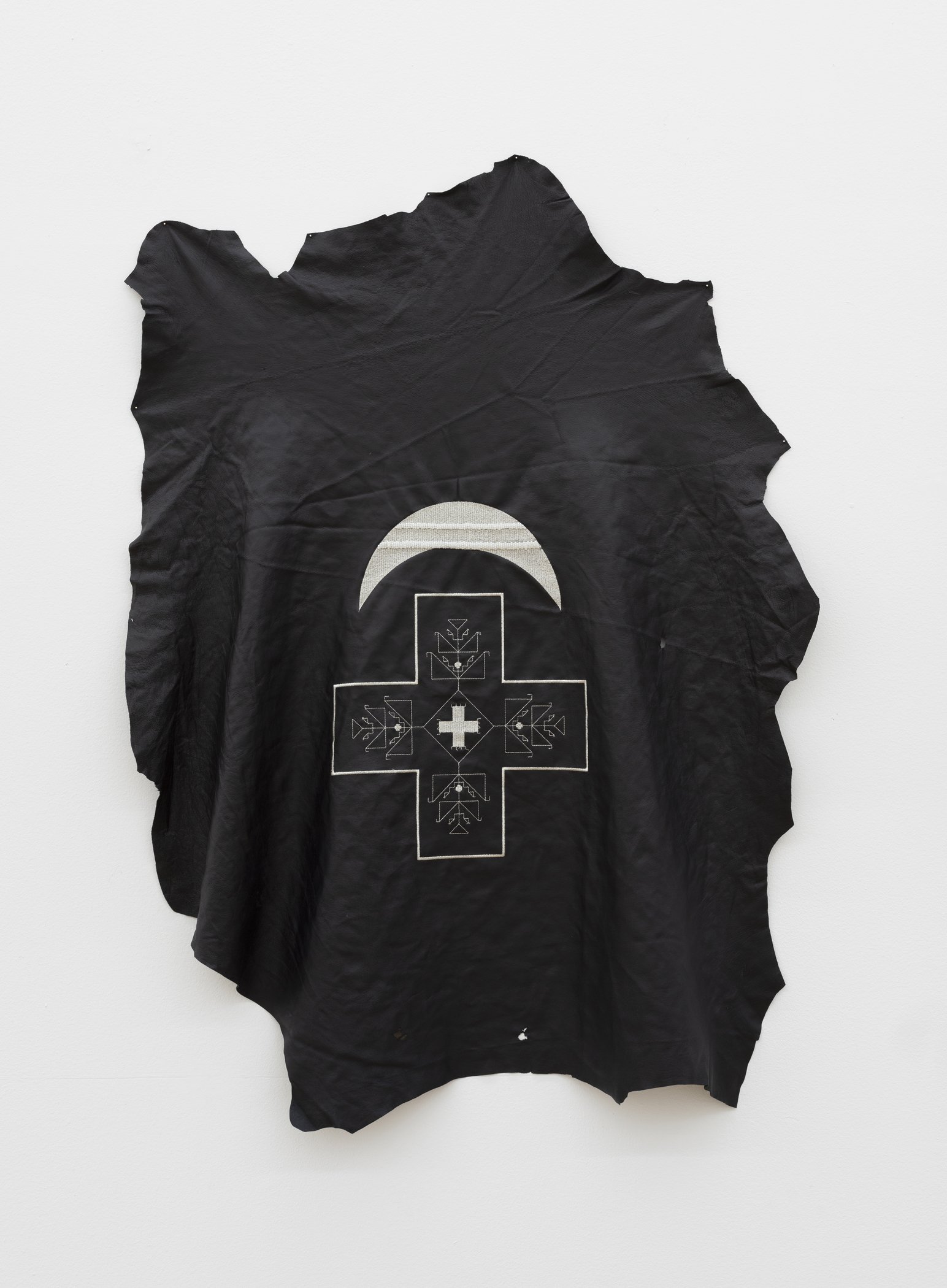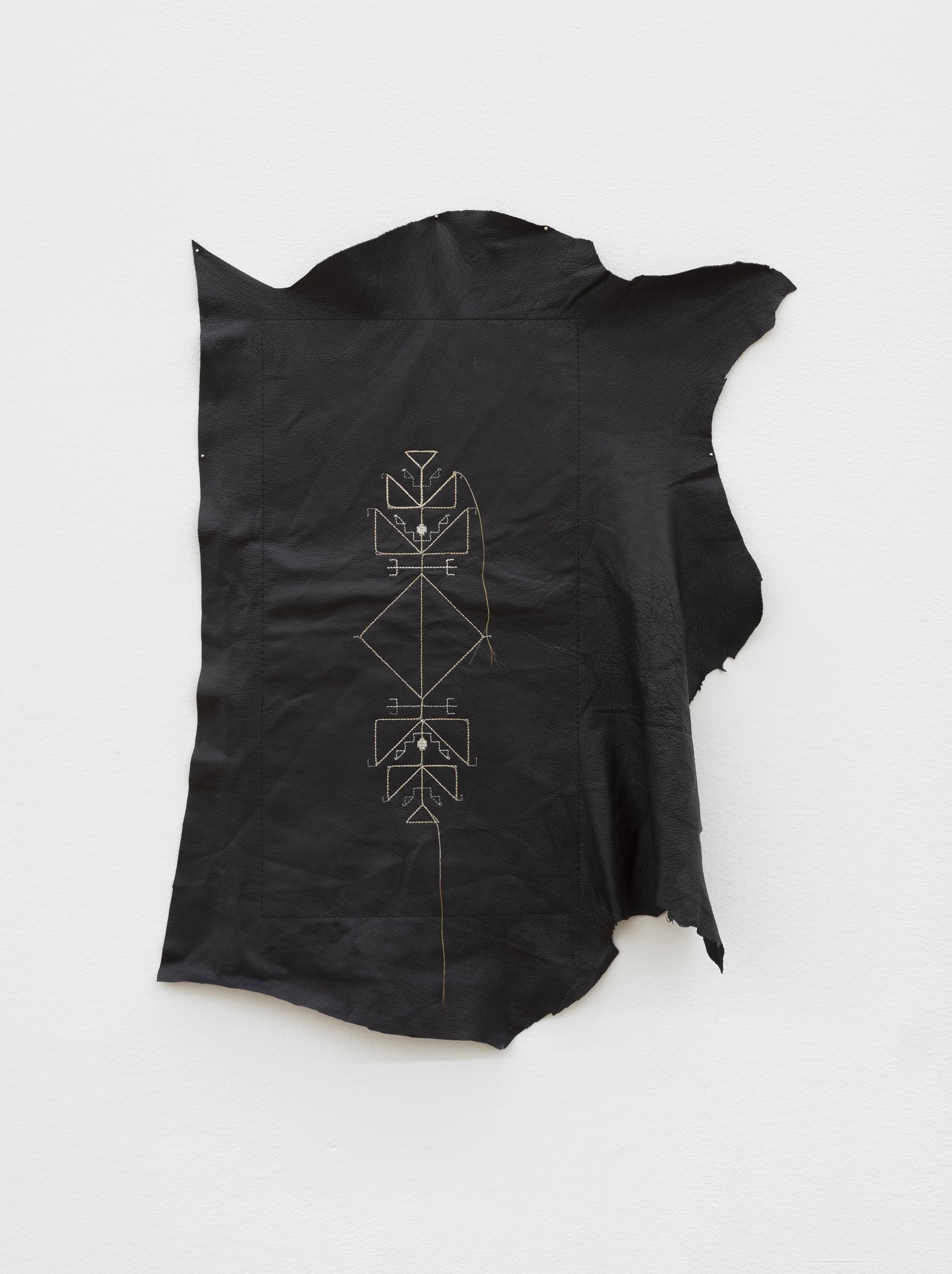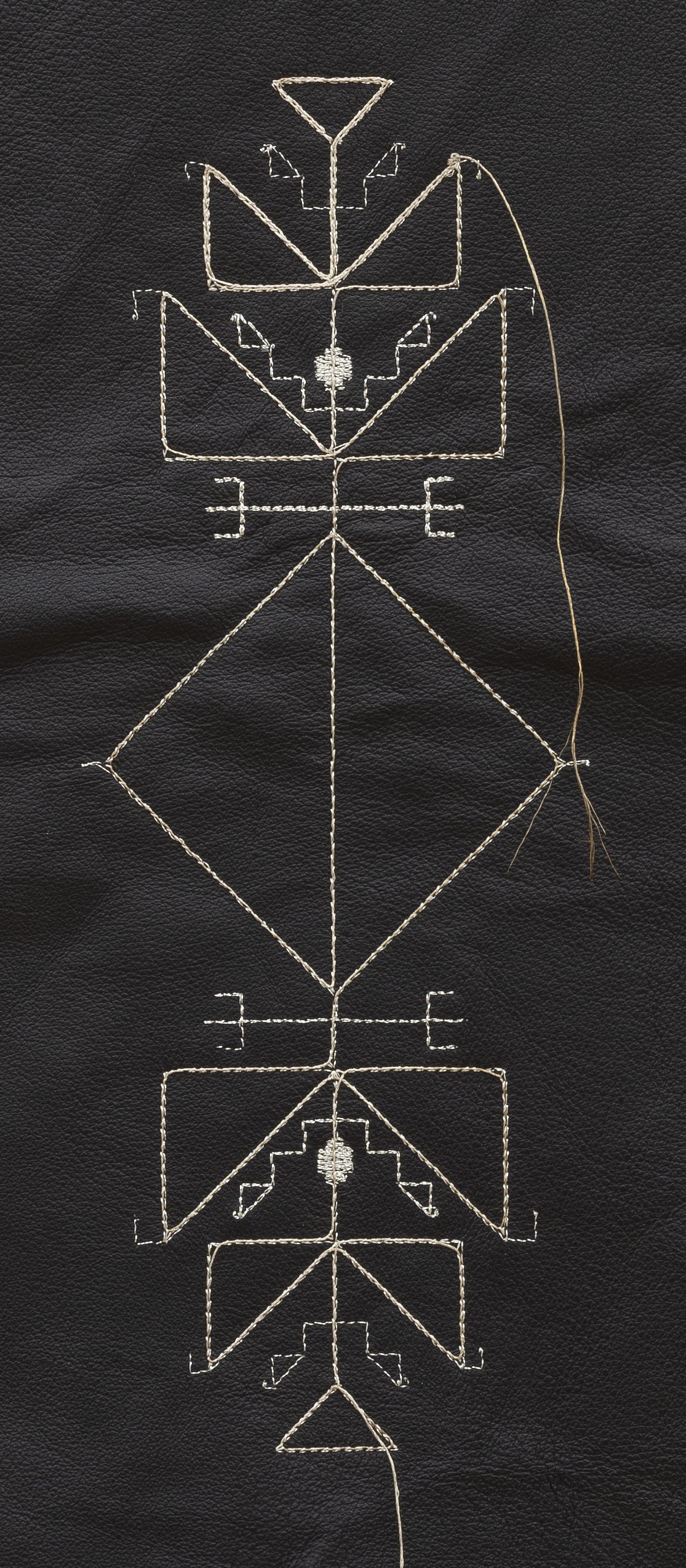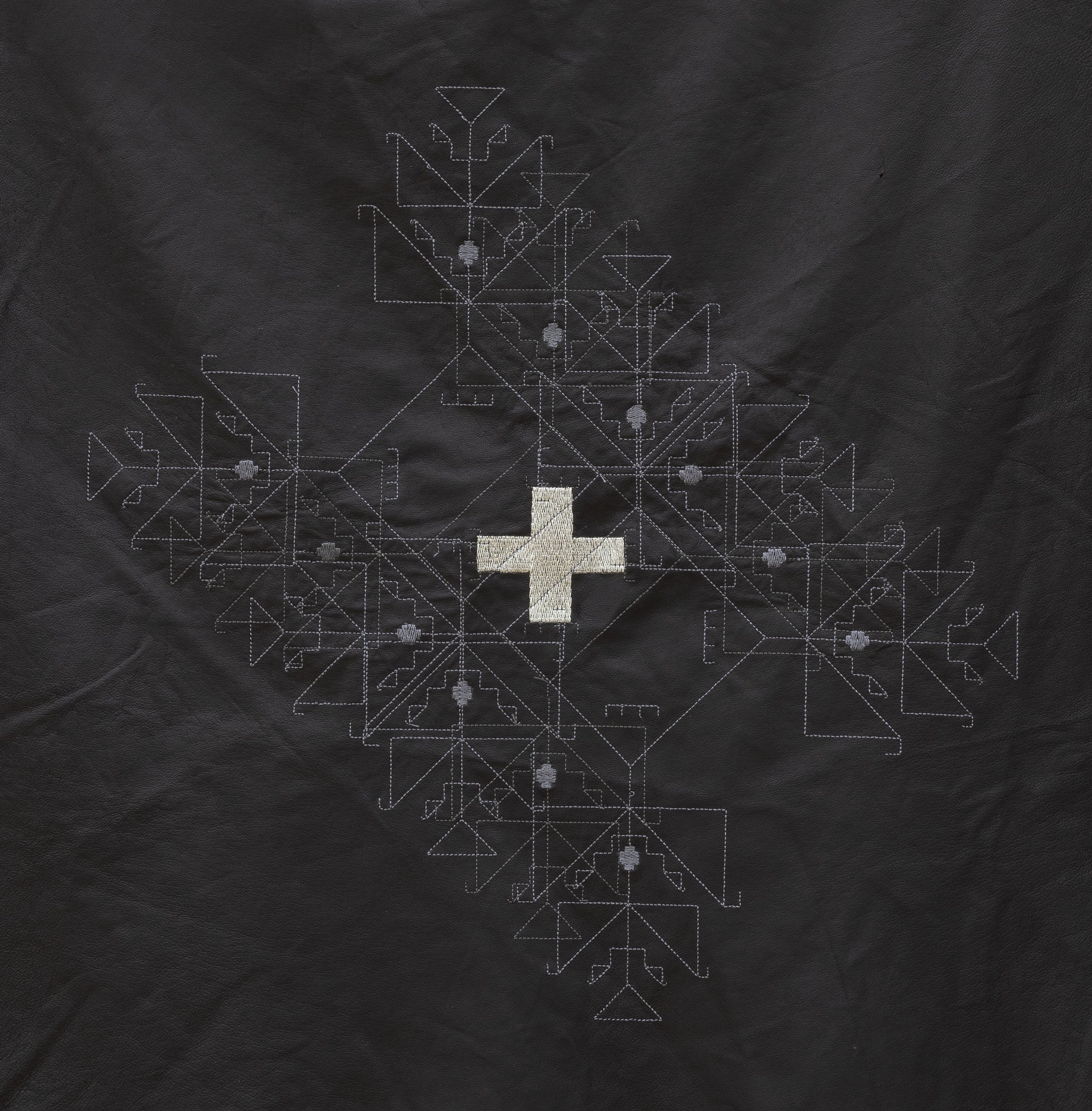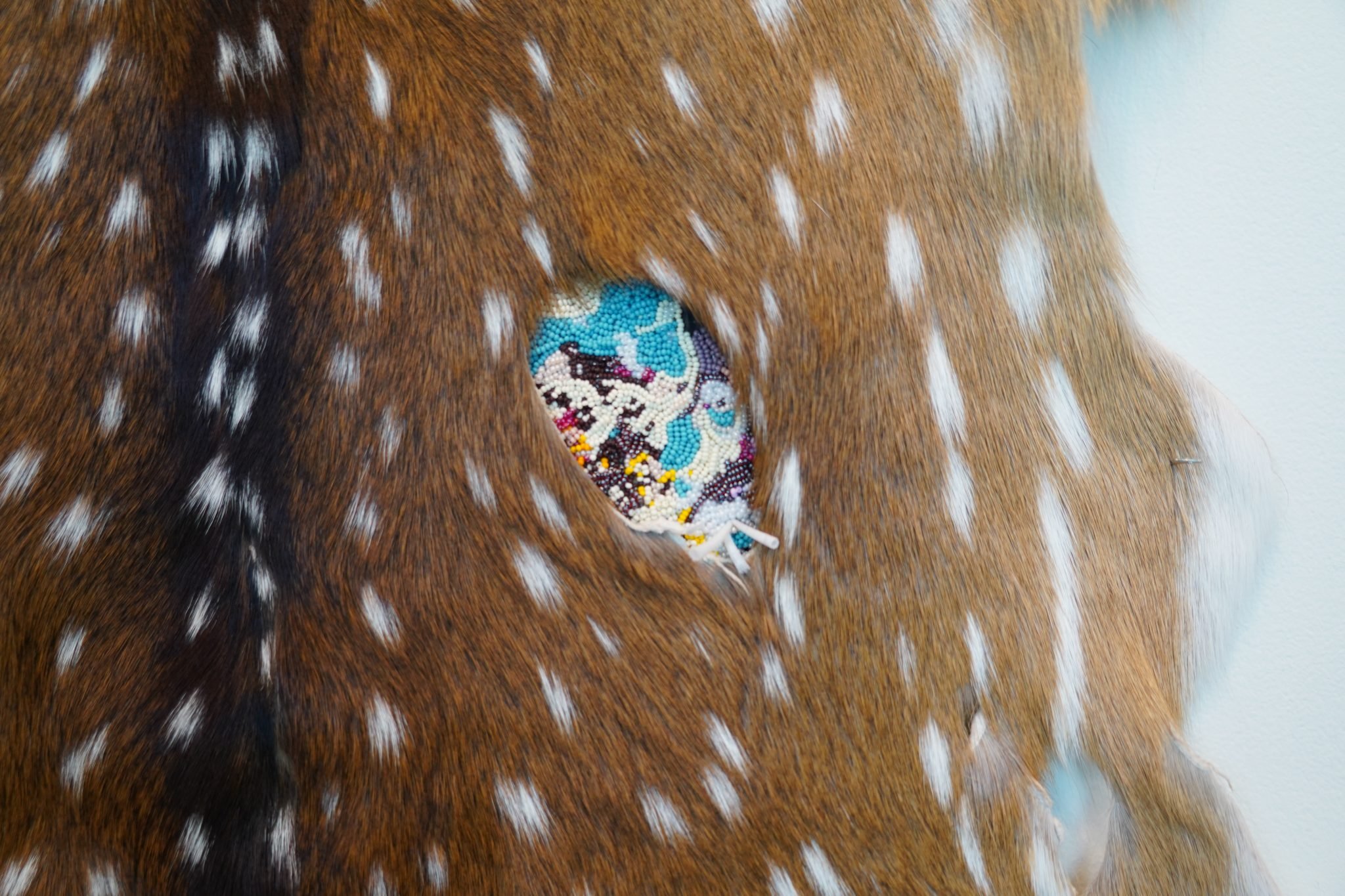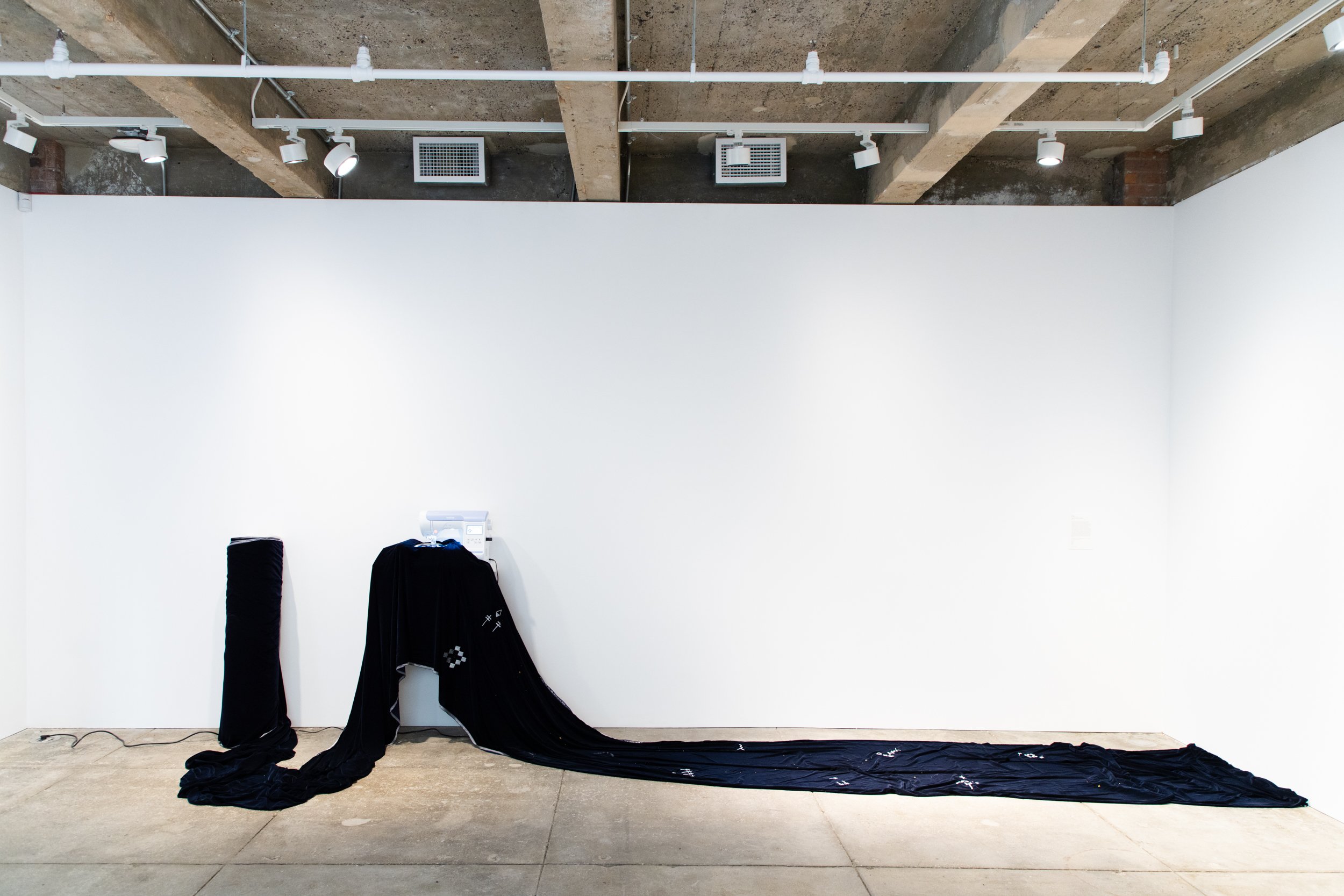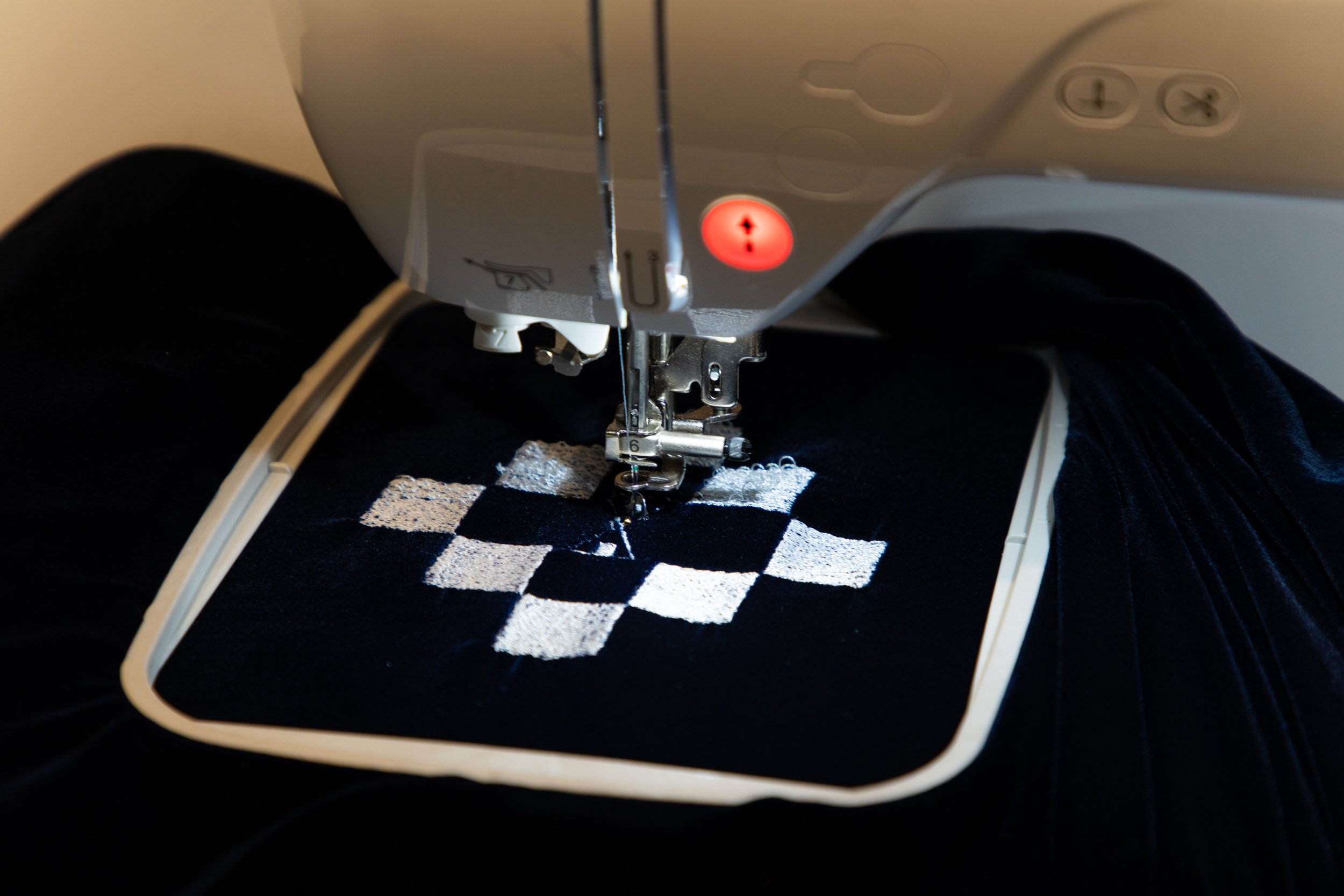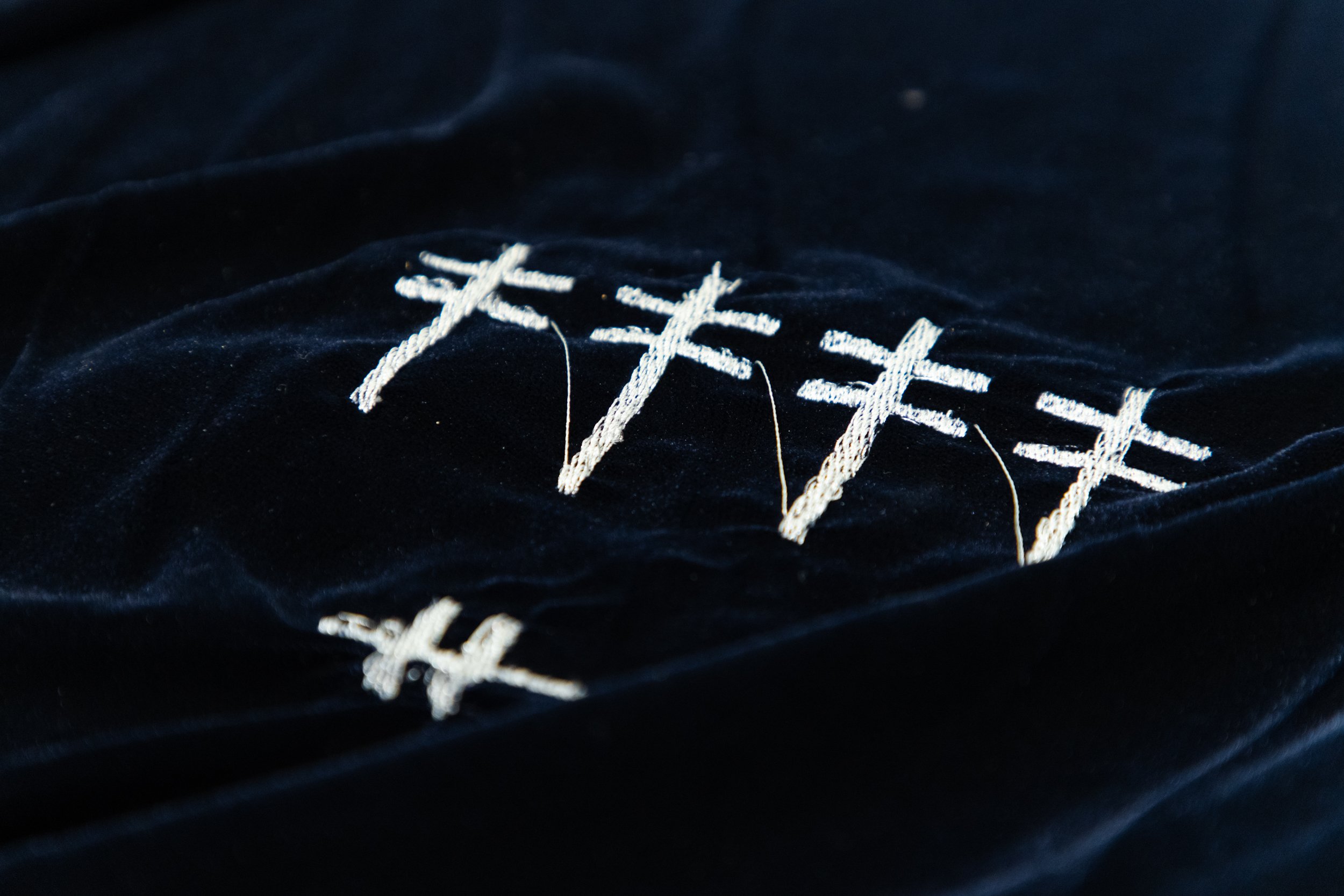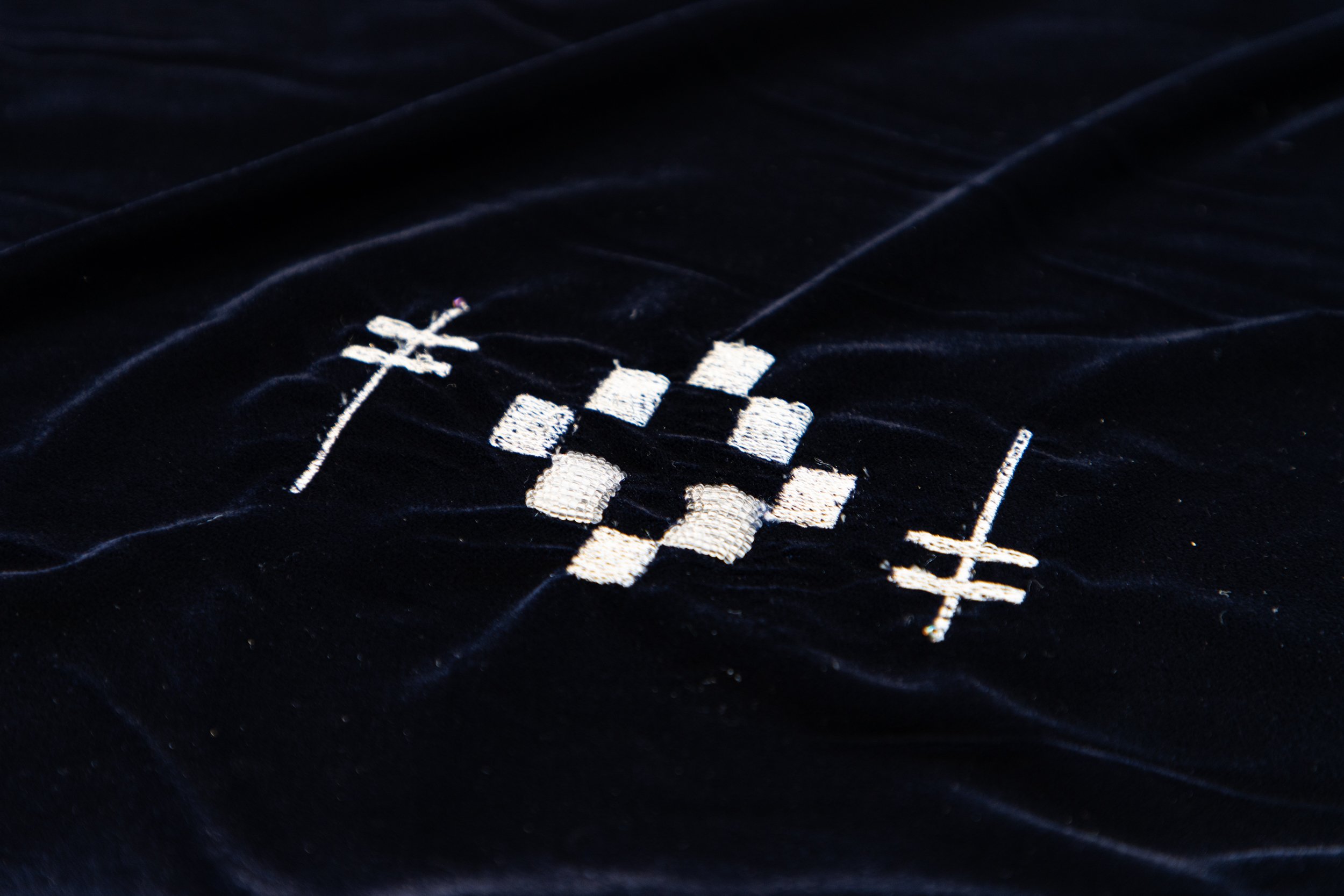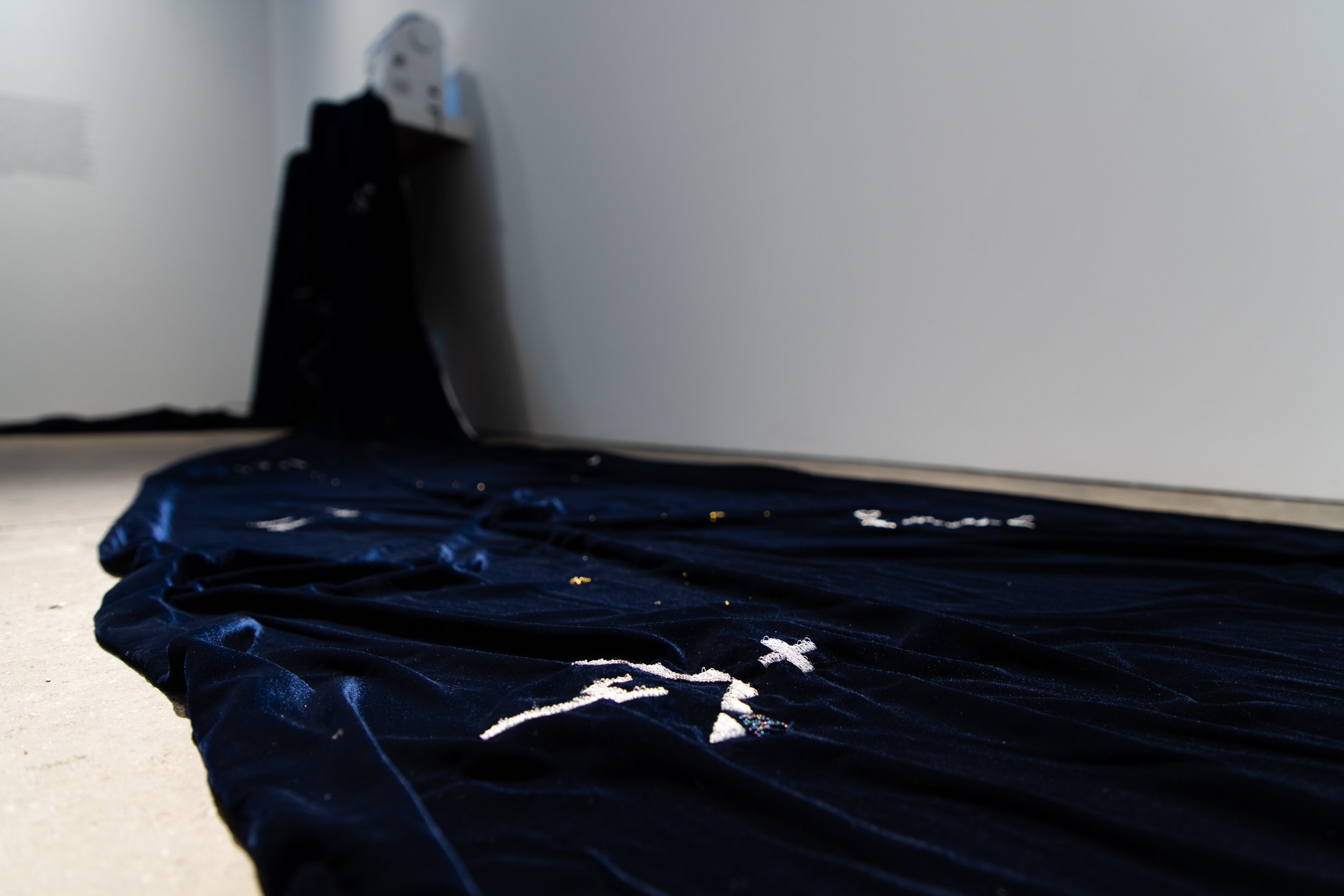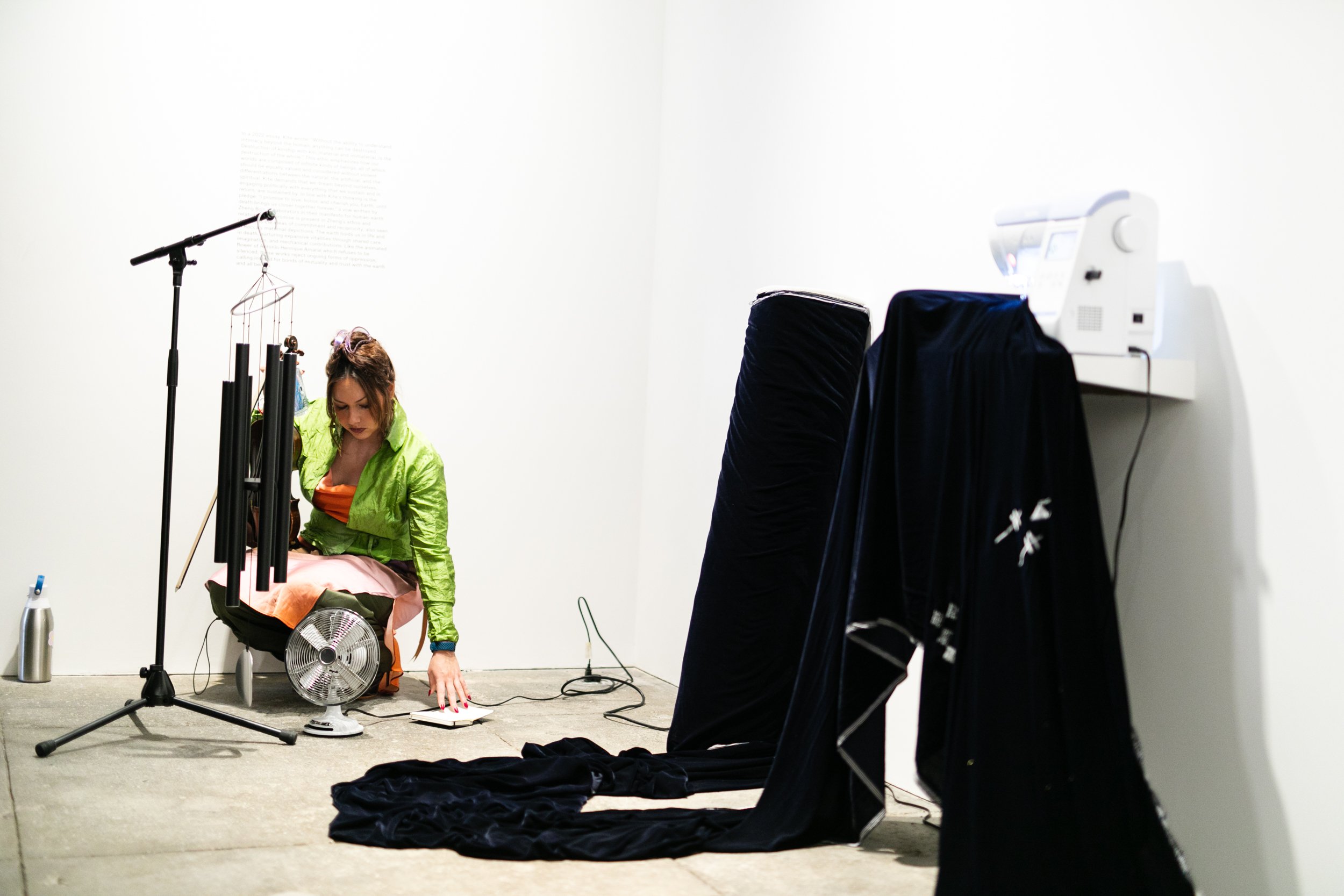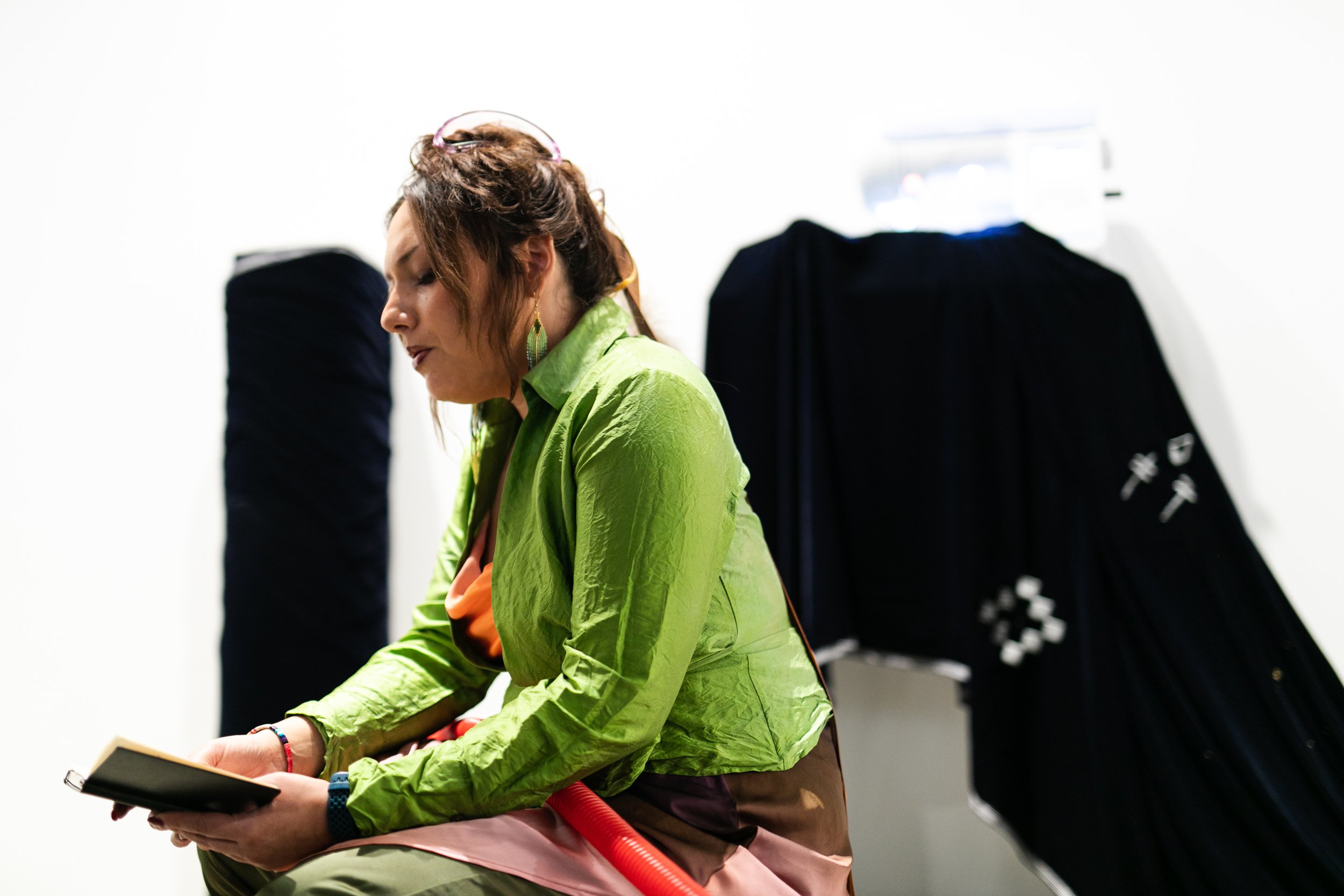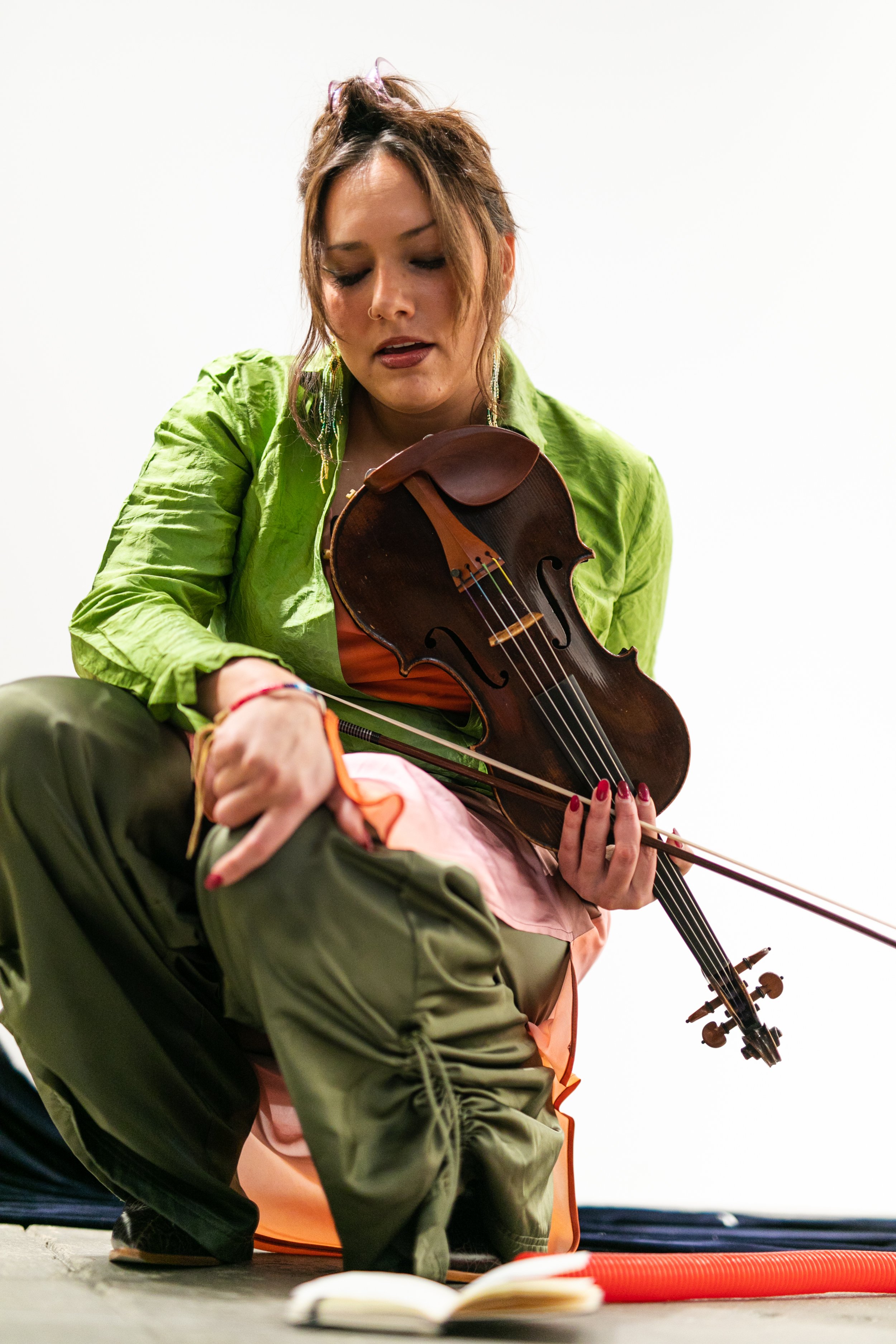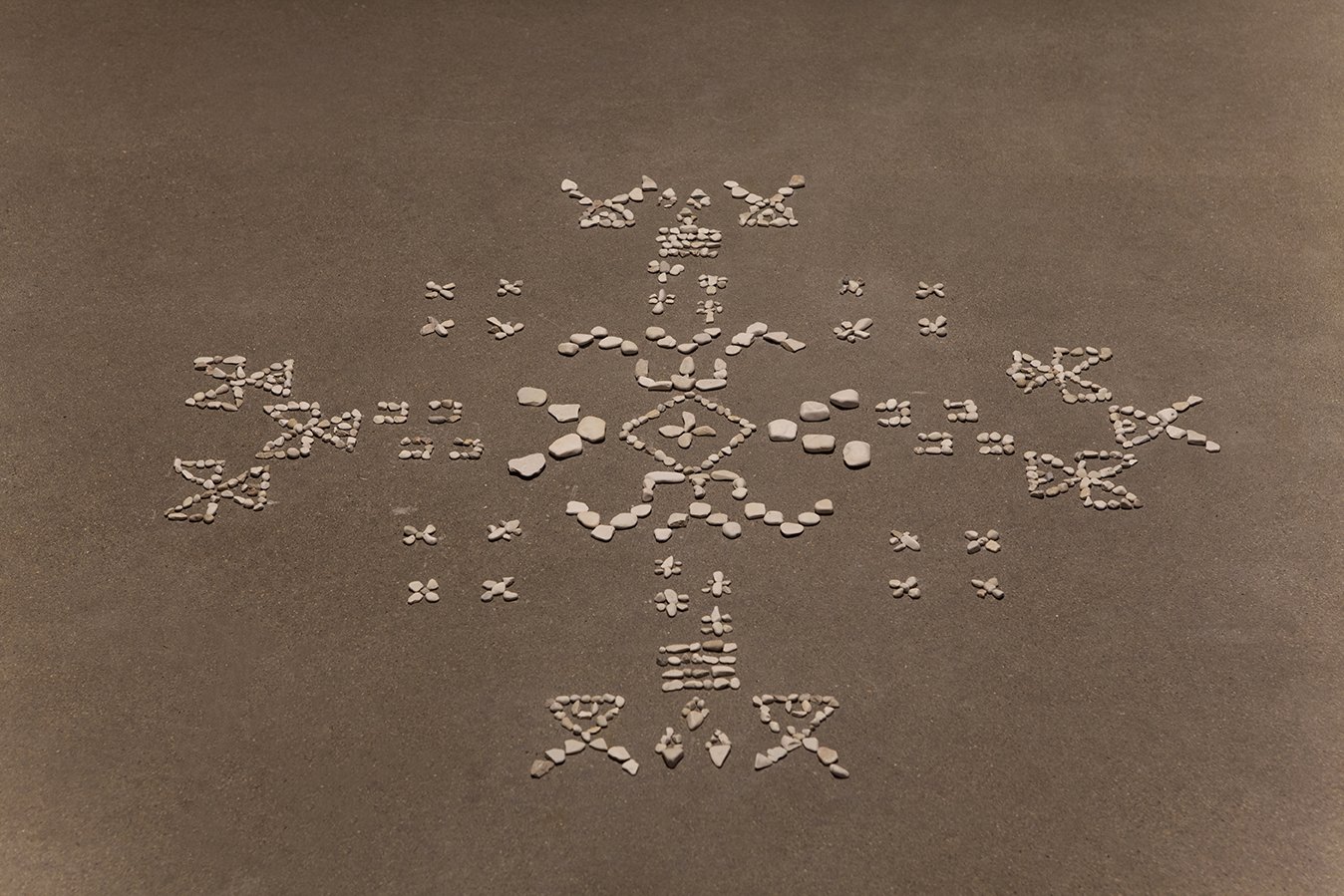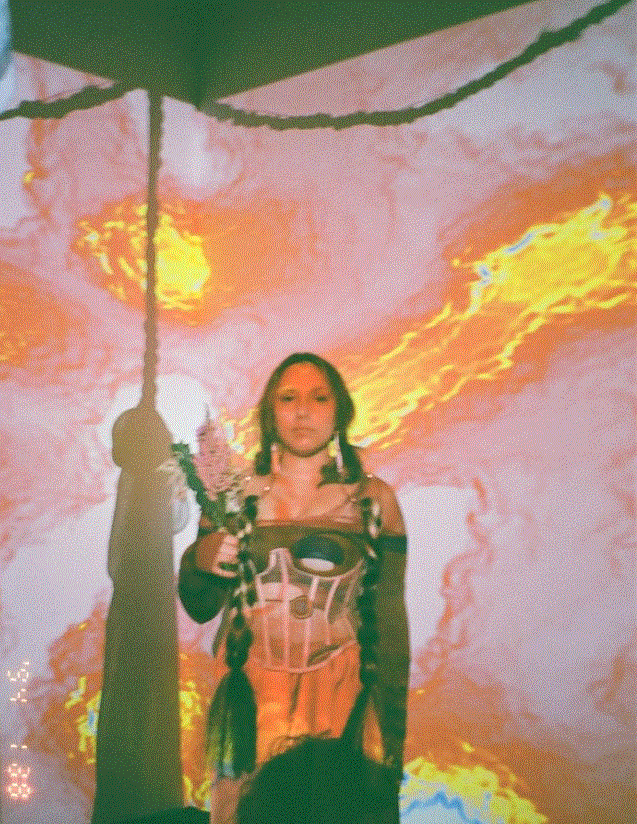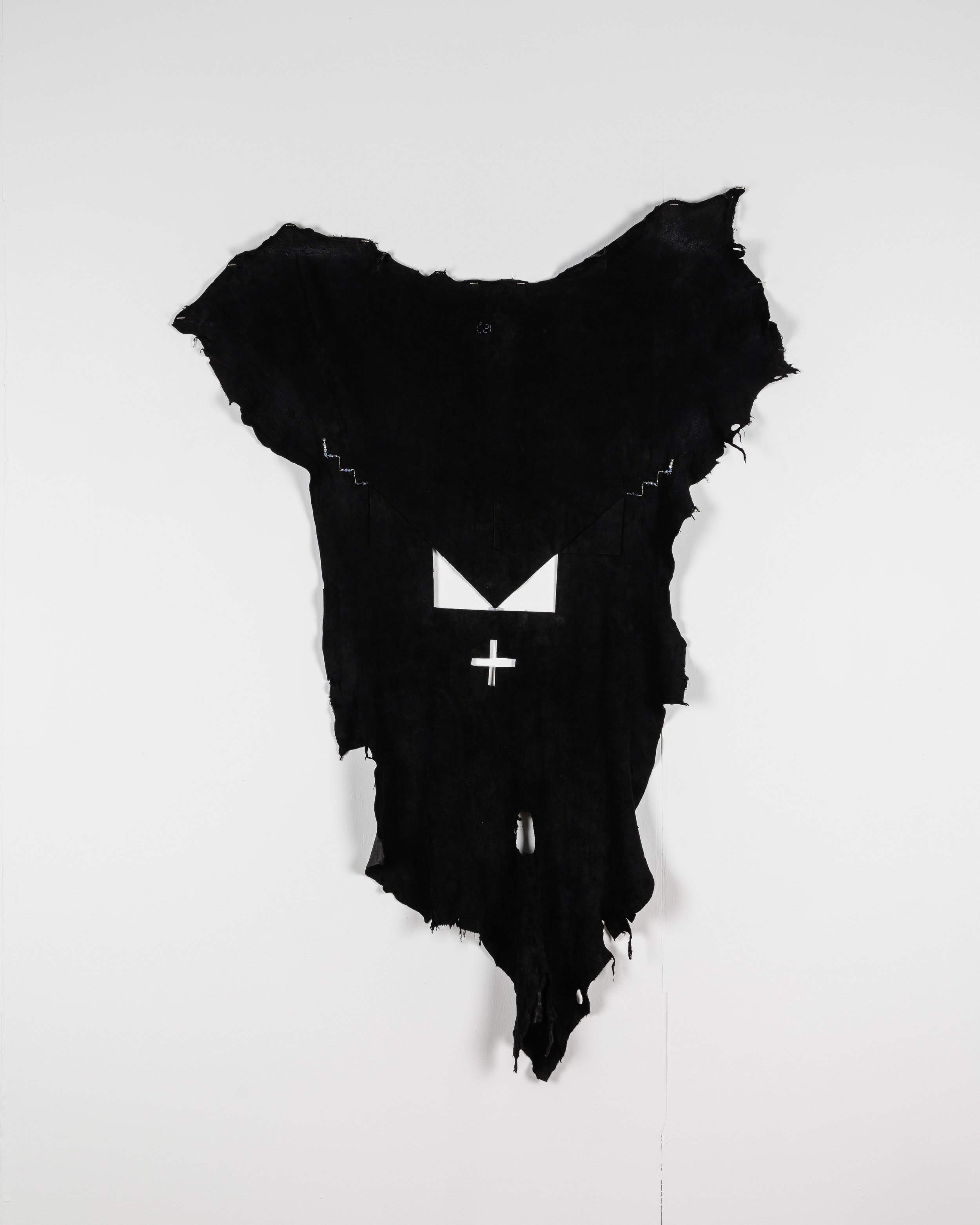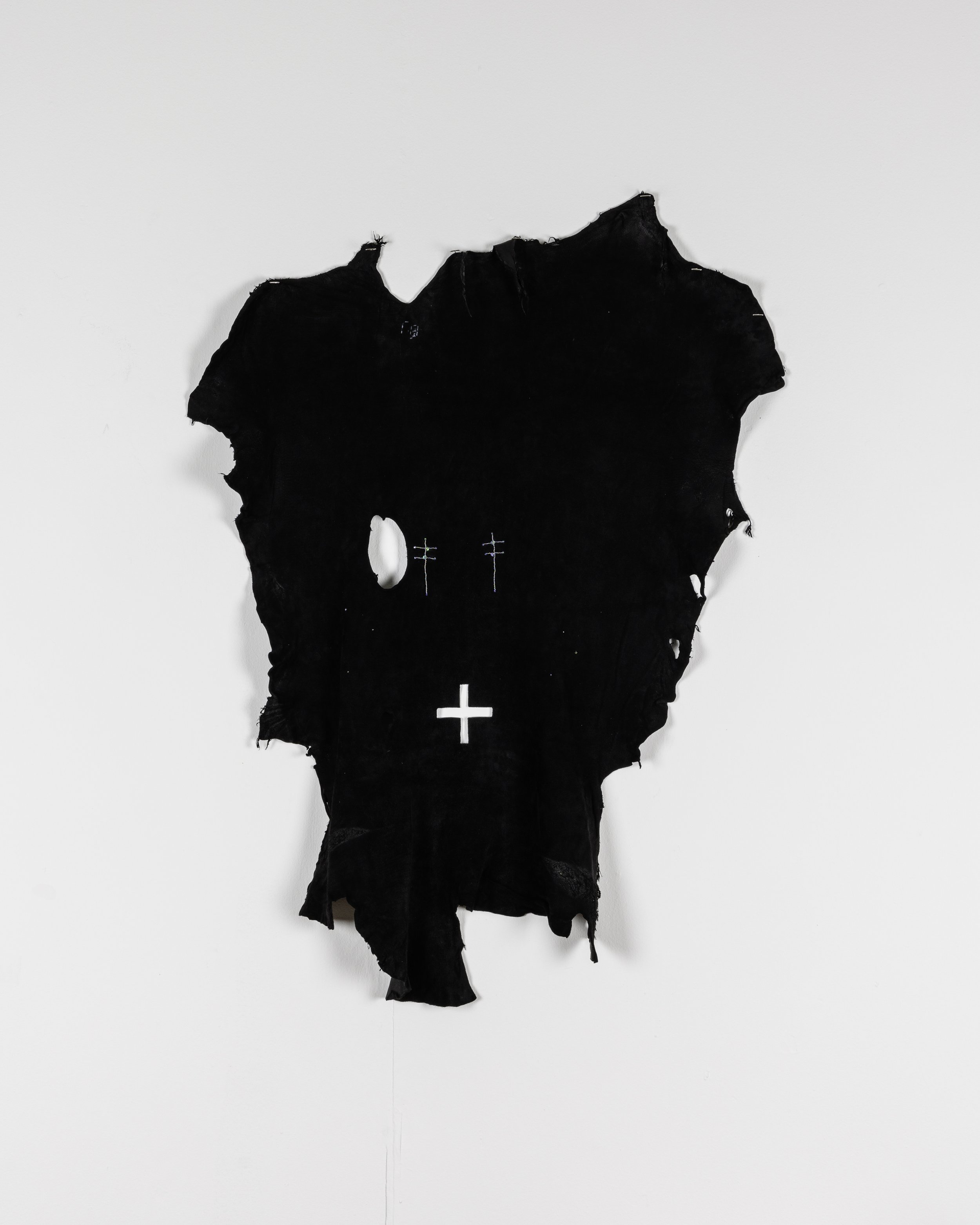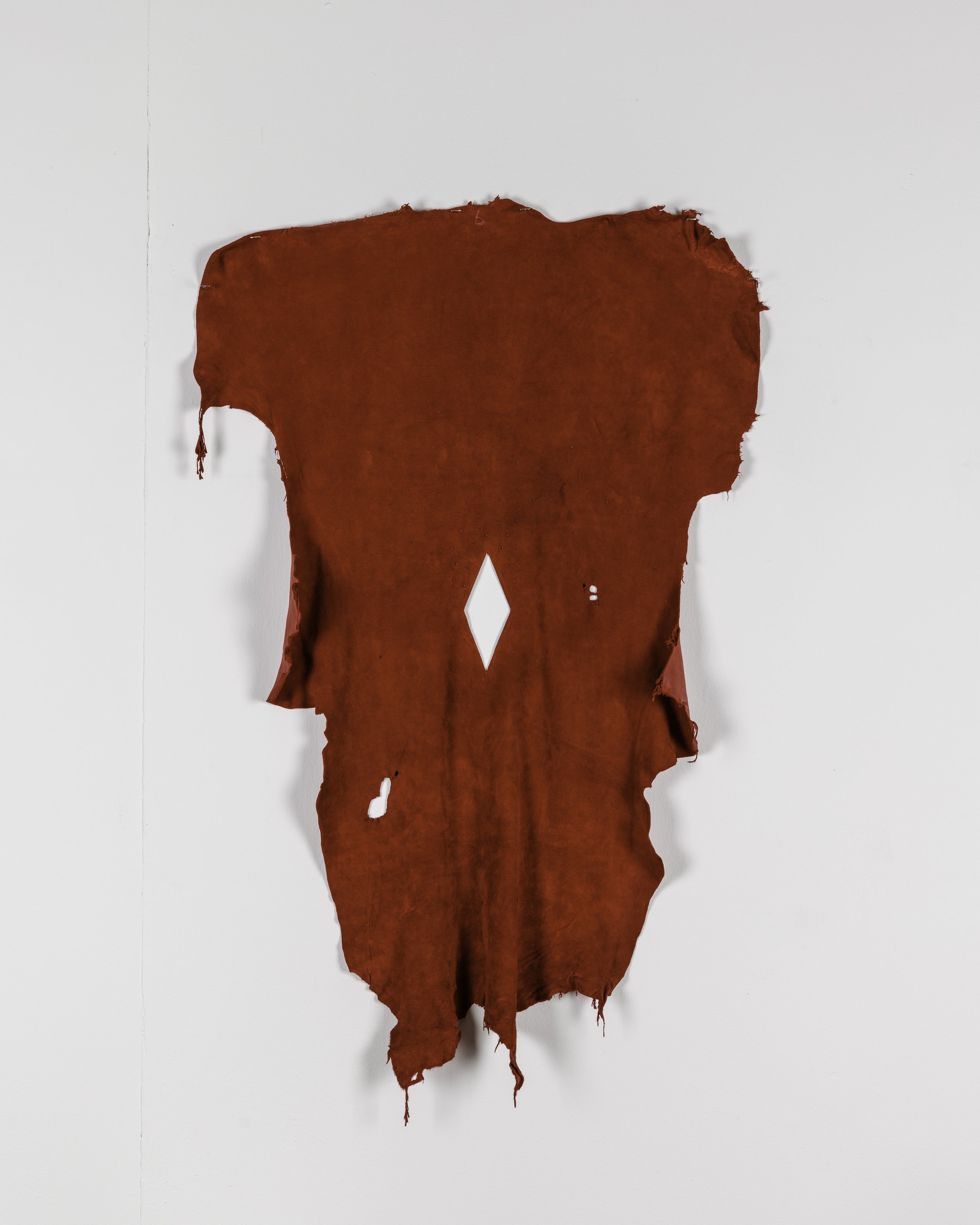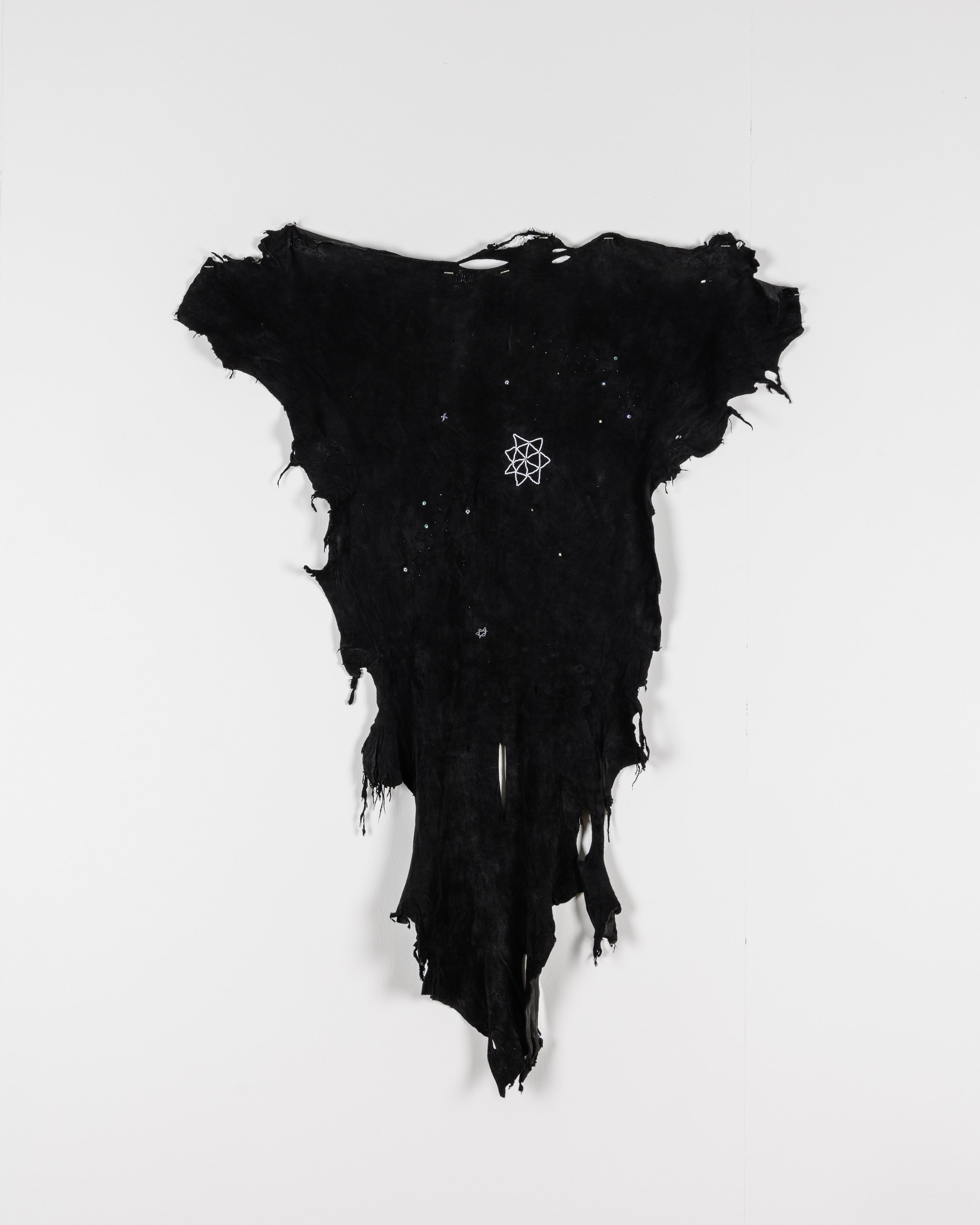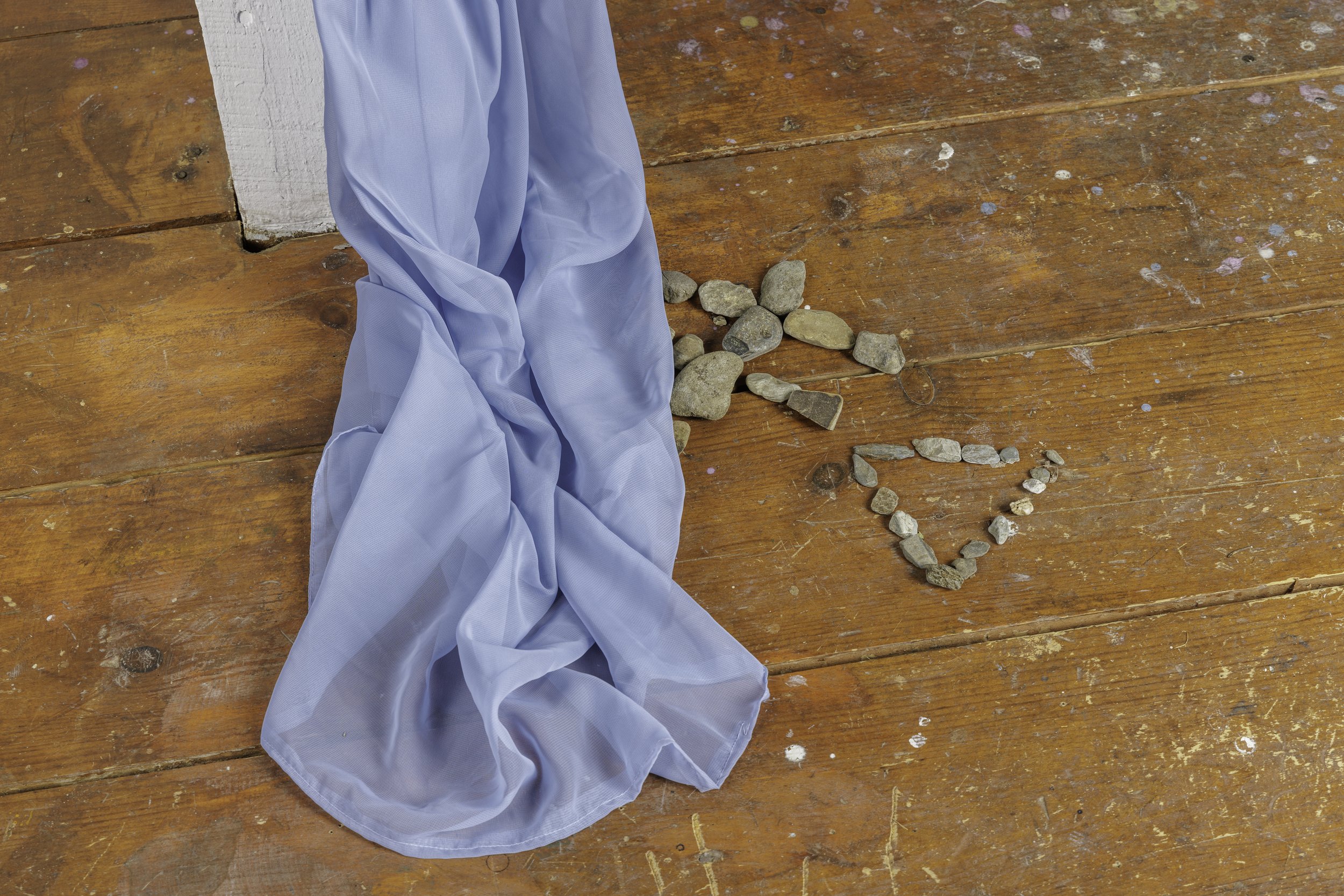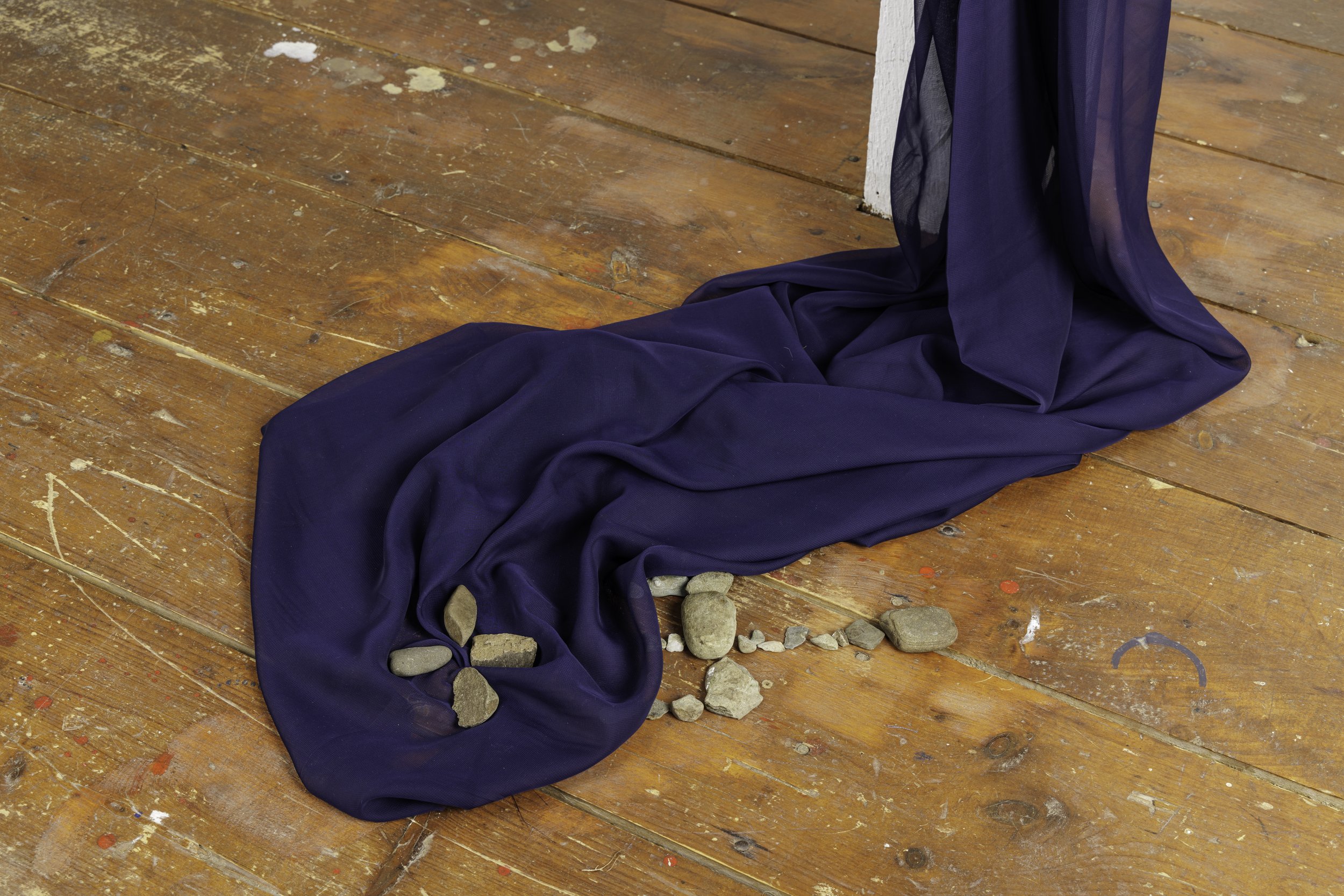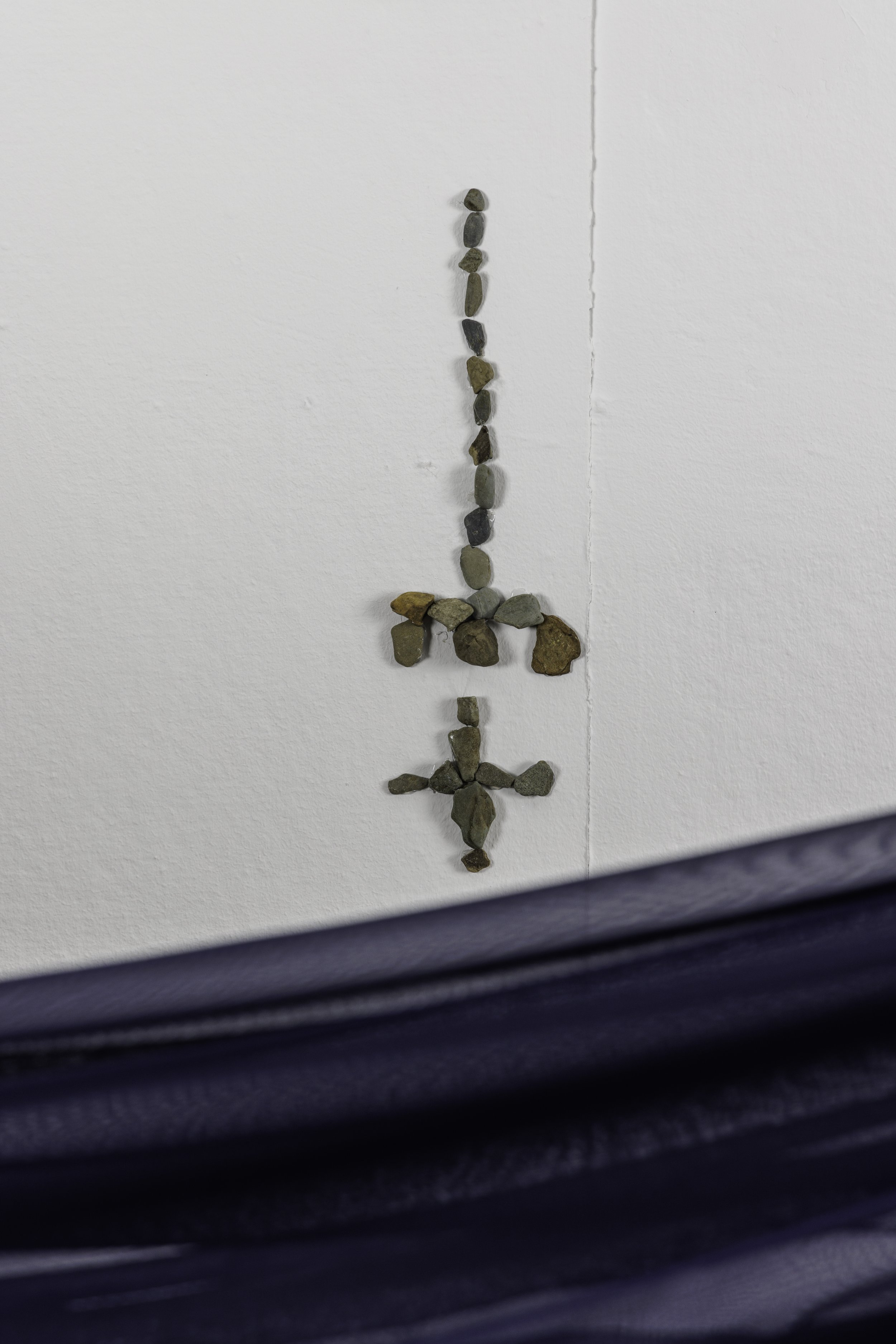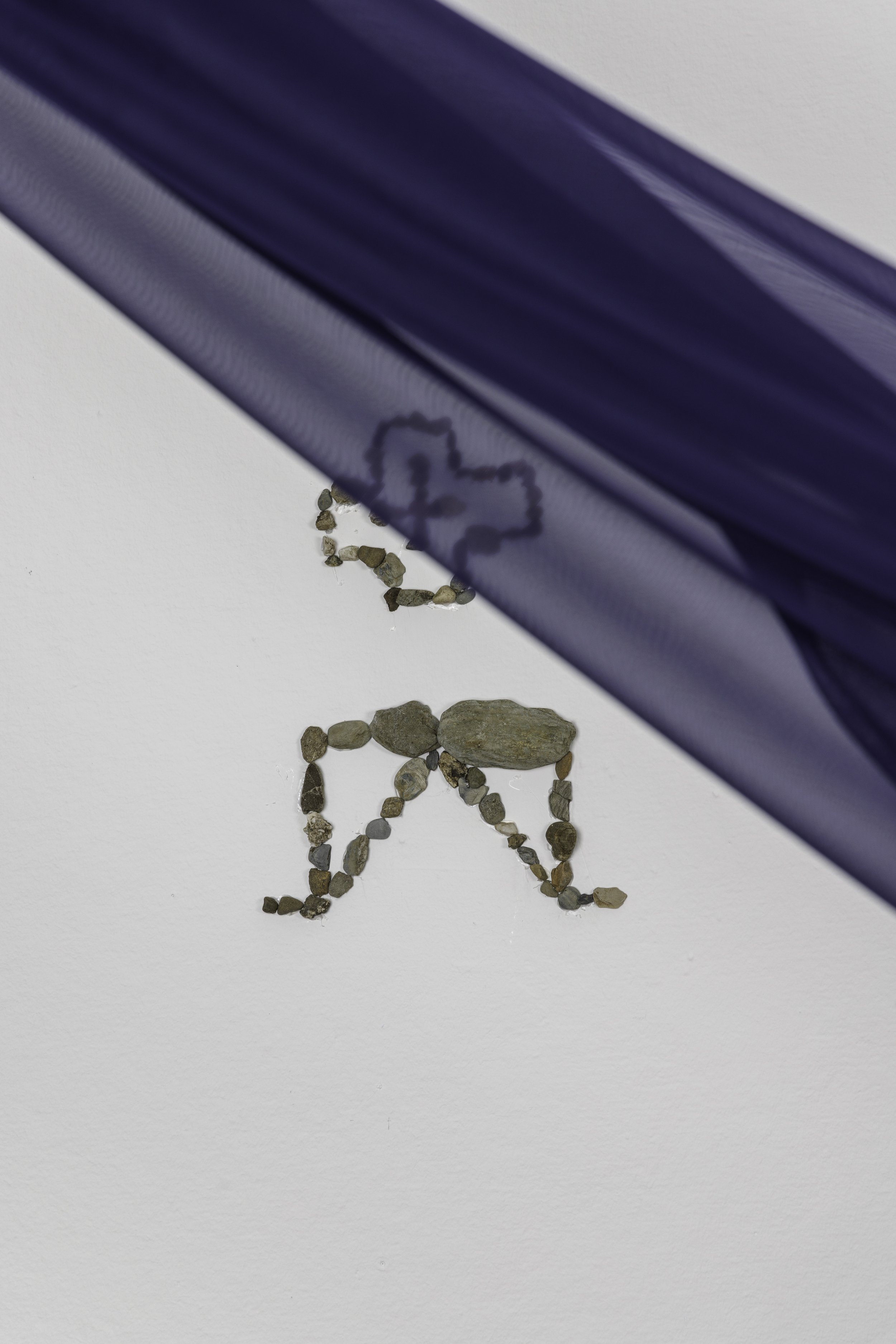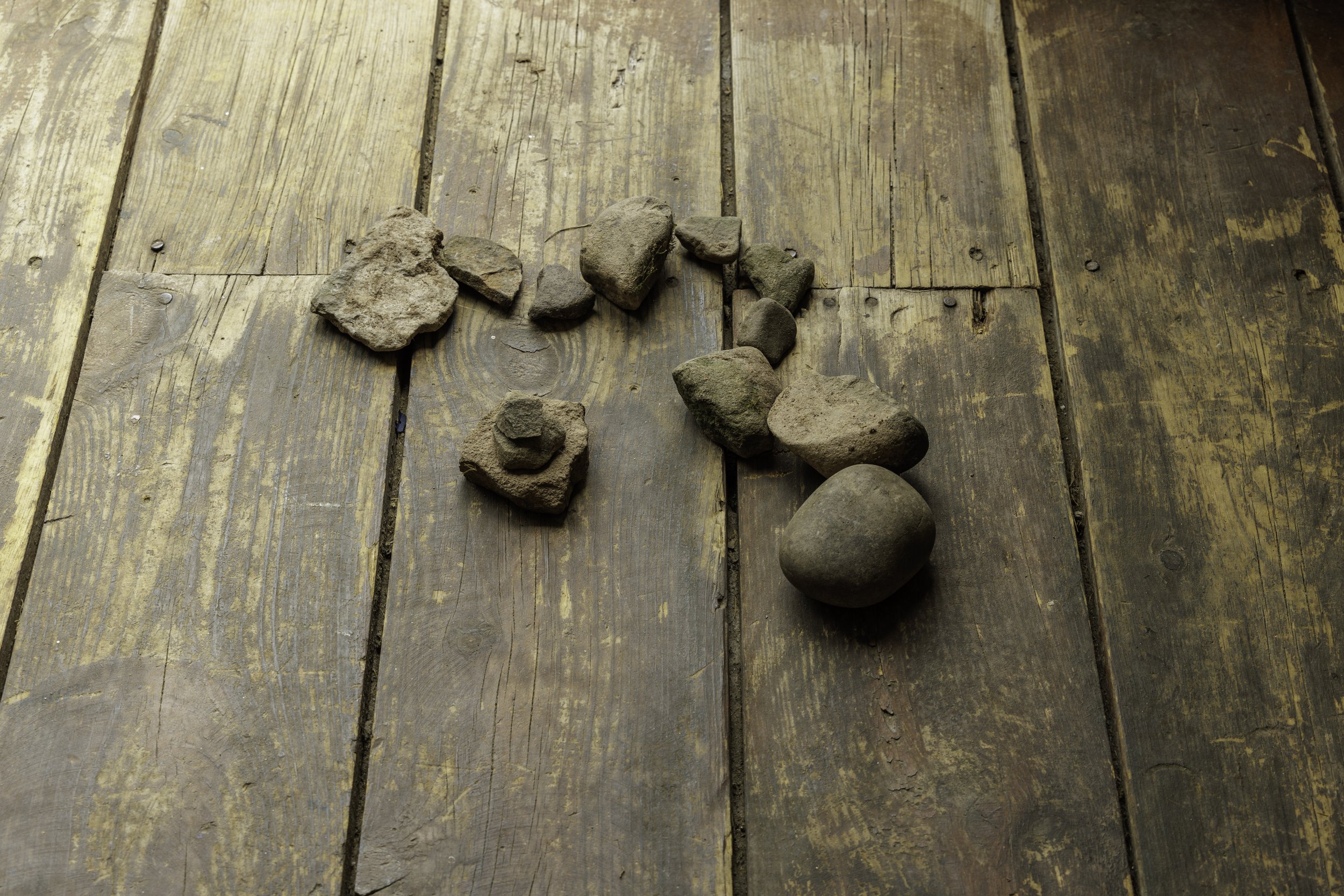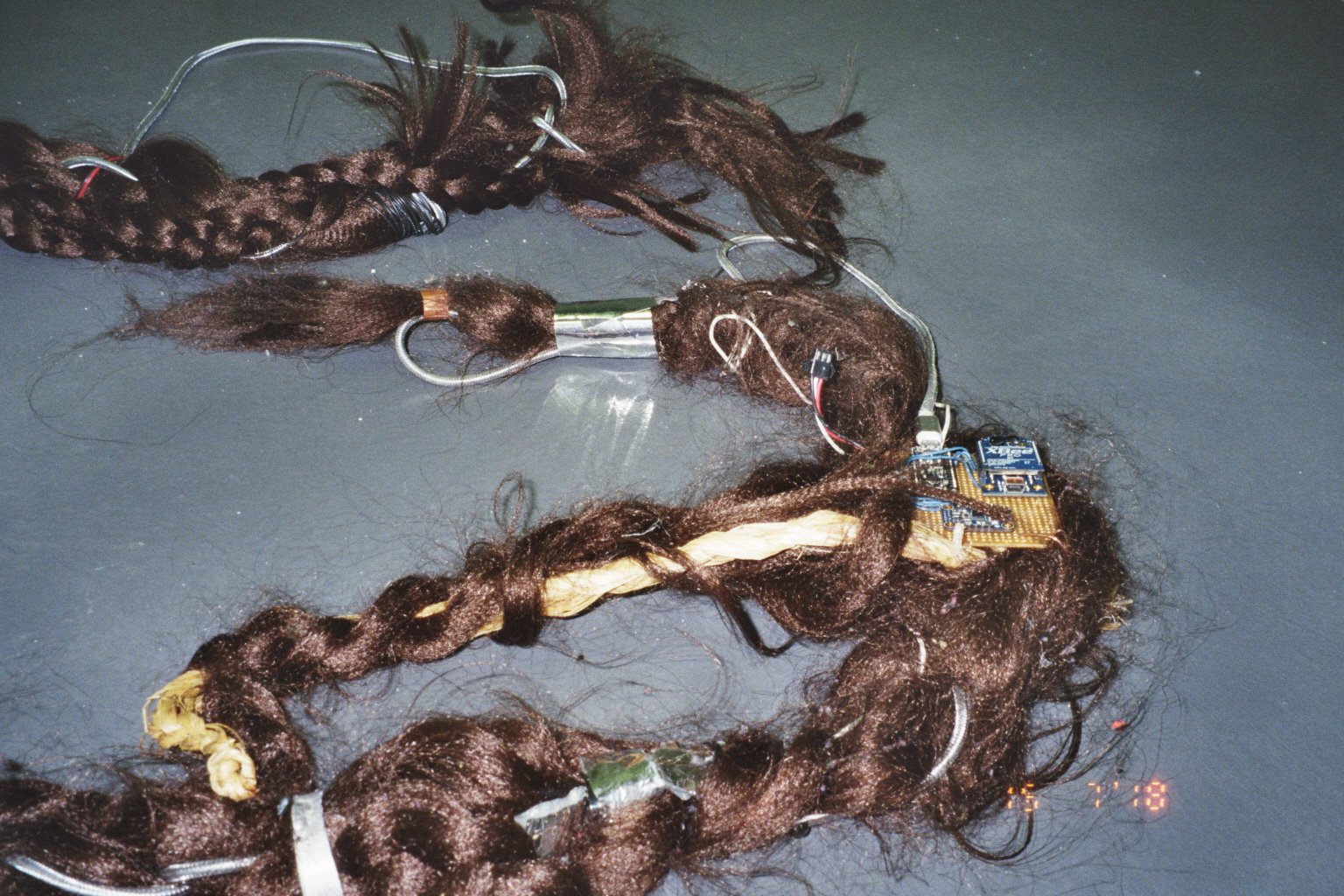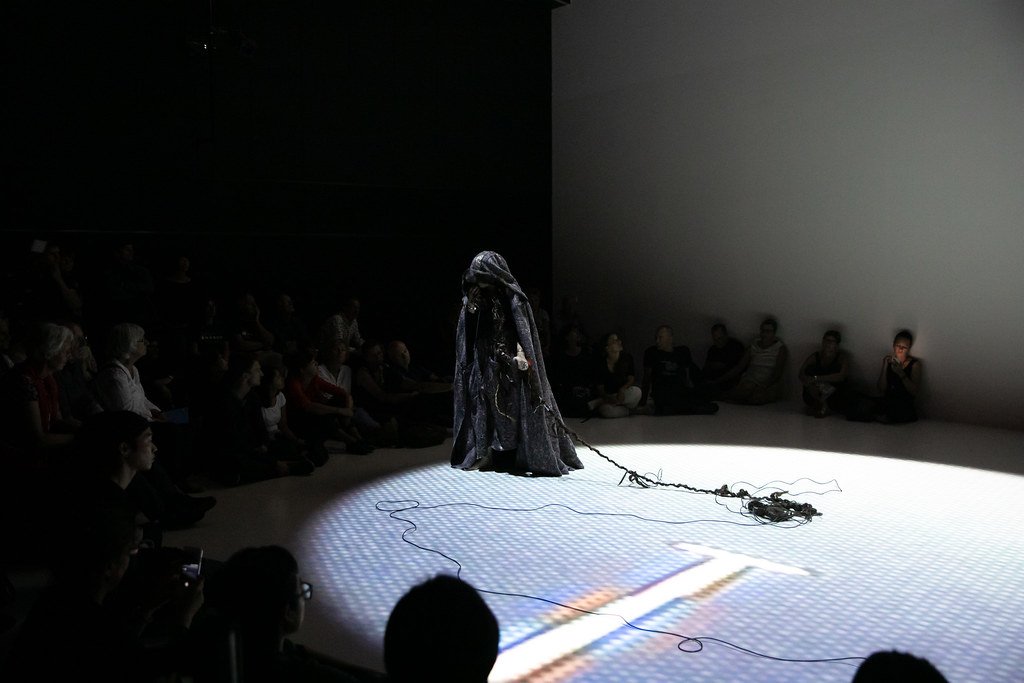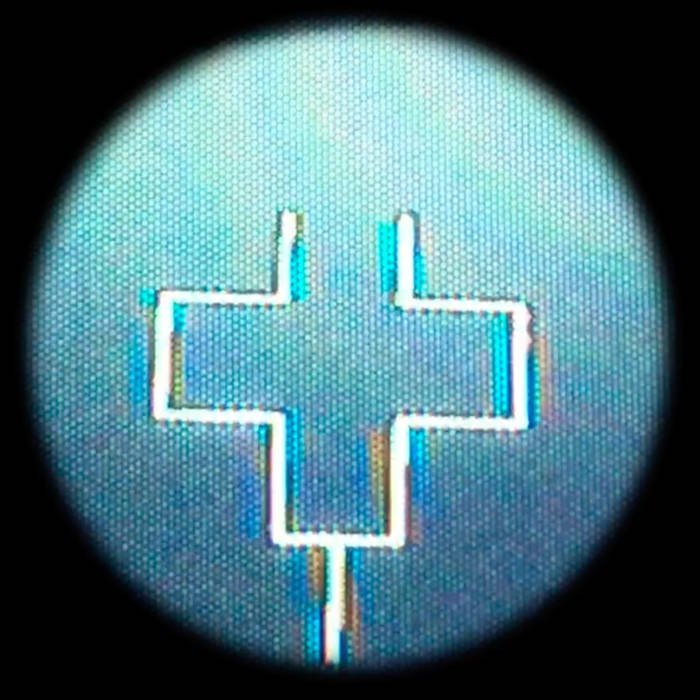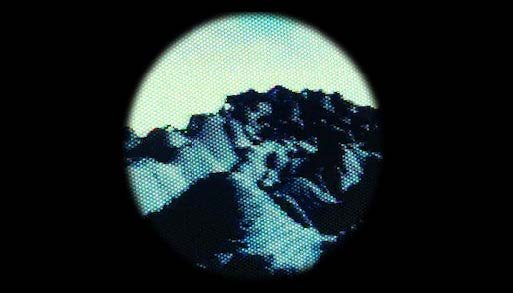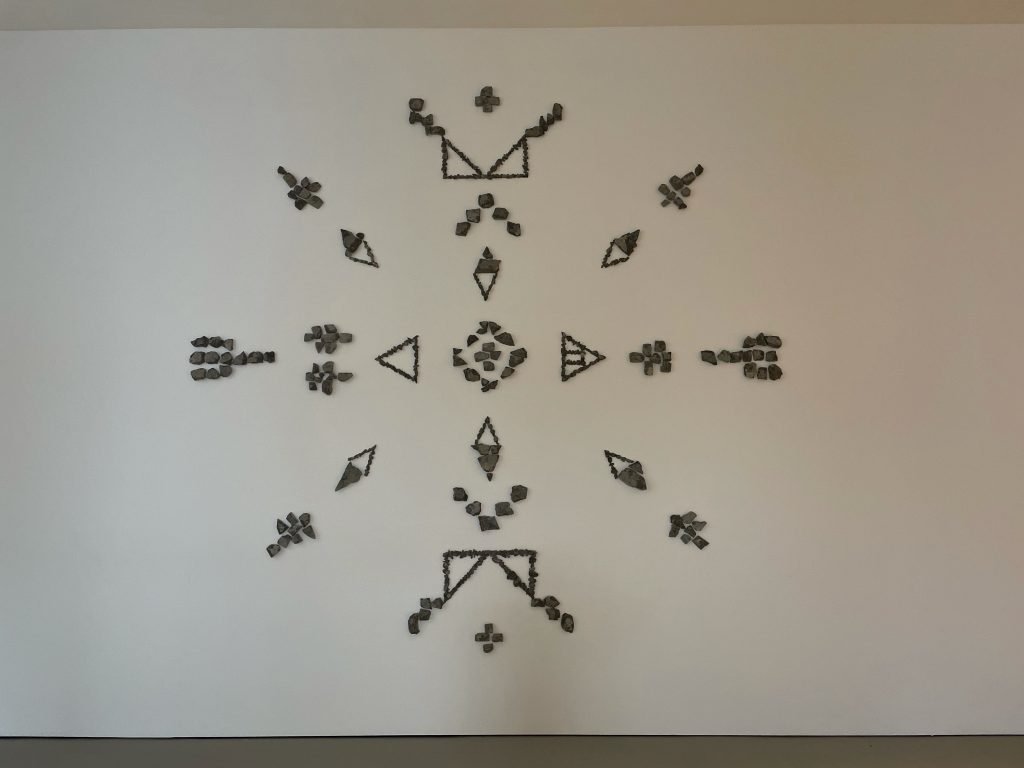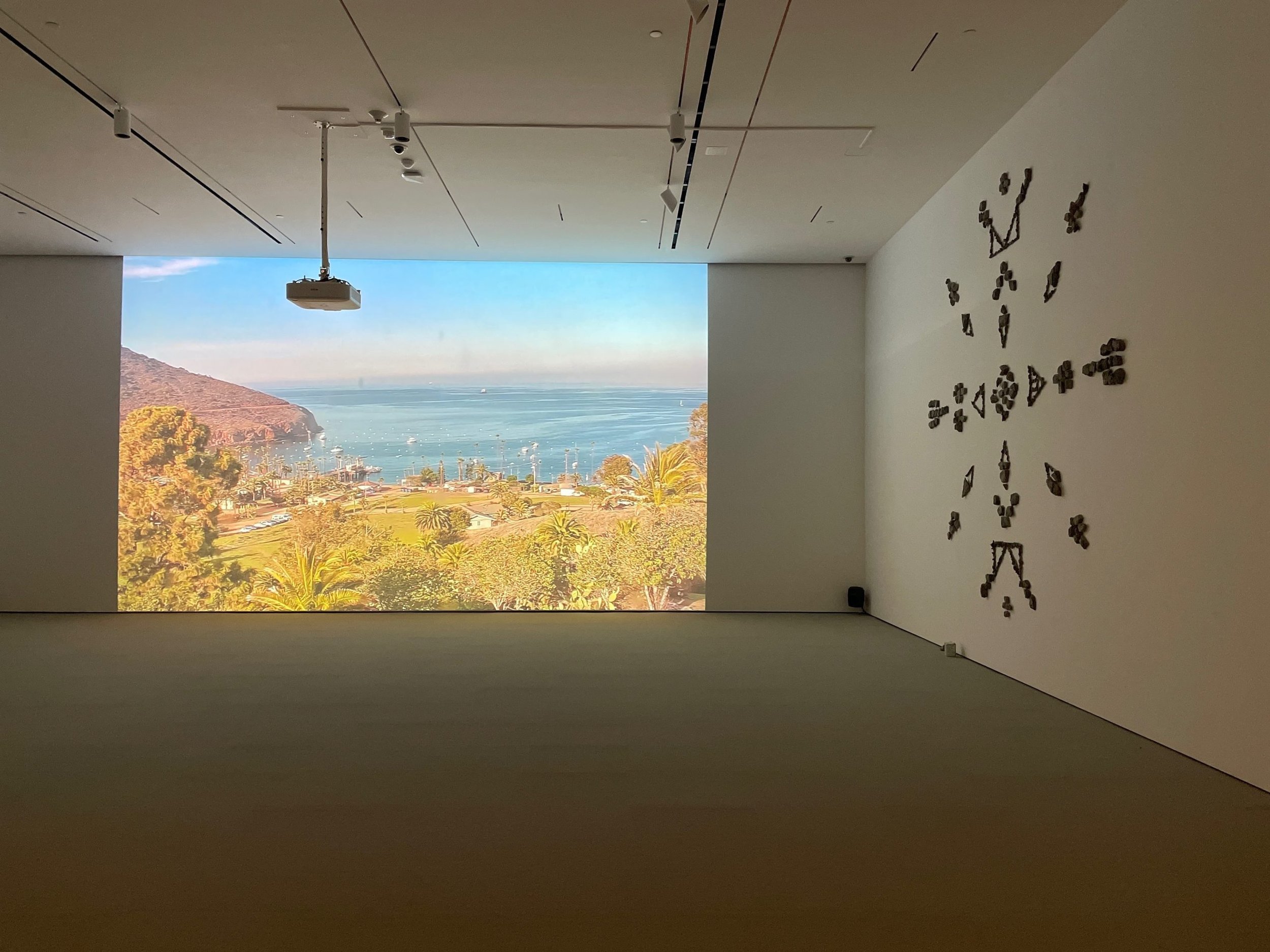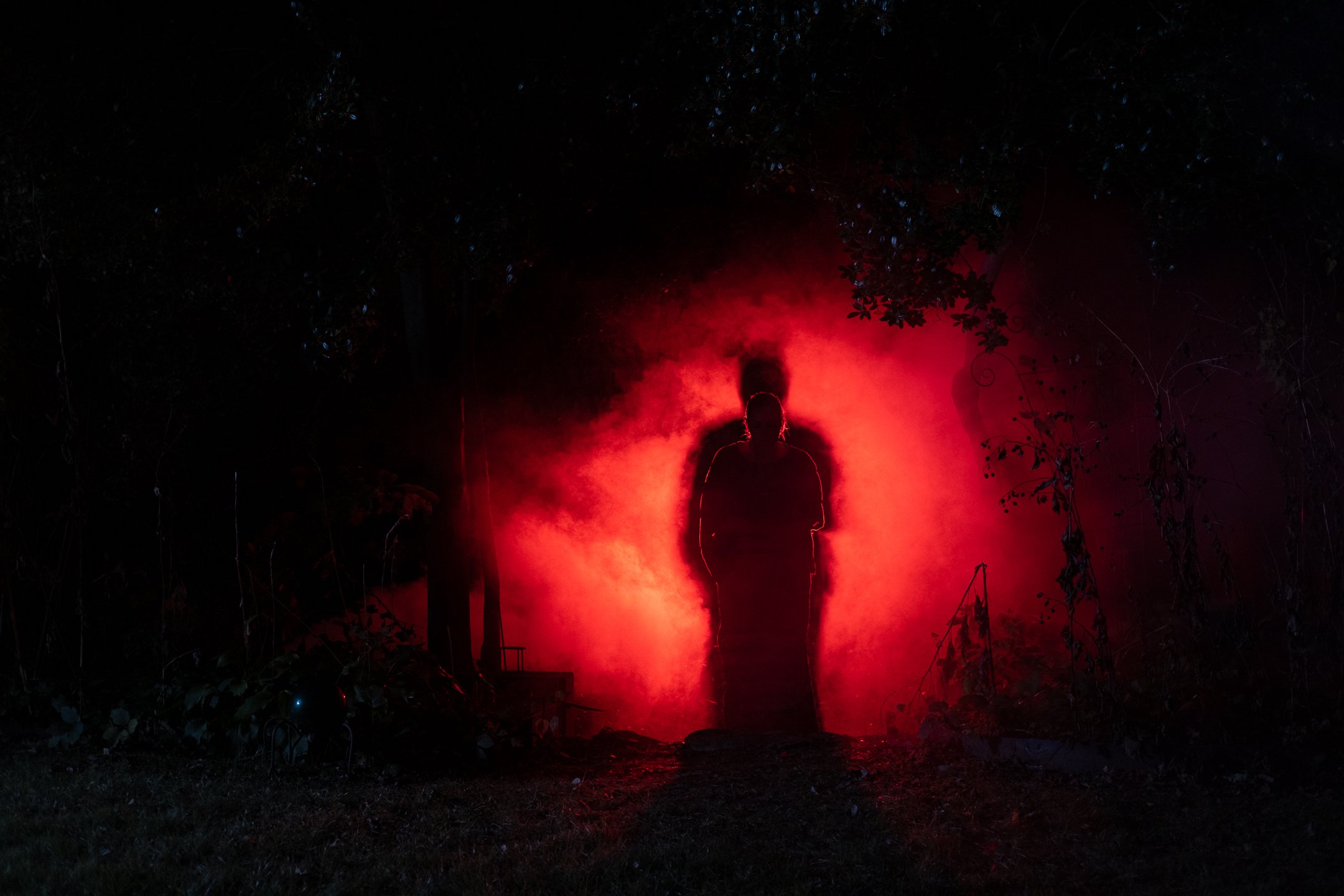Cosmos Cinema - Shanghai Biennale
Description
Artworks
Wičháȟpi Wóihaŋbleya (Dreamlike Star), Kite, 2023, site-specific Installation.
Wičhíŋčala Šakówiŋ (Seven Little Girls), Kite, 2023, site-specific Installation.
Osnáze škȟá kiŋ iléǧe. (Nevertheless, the scar shines.), Kite, 2023, site-specific Installation.
AŊPÁWI AÍYOKPAZA, A Solar Eclipse Performance
Photos by Blair Speed
Description
Kite, AŊPÁWI AÍYOKPAZA, Solar Eclipse Performance.
Title pronunciation: [On-PAH-wee Ah-ee-YOKE-pah-ZAH]
“Kite’s interdisciplinary practice spans sound, video, performance, instrument building, wearable artwork, poetry, prose, interactive installations, and more. As part of her performance practice, she composes ‘visual scores’ for musicians using components of geometric language identified in linguist Sadie Red Wing’s Lakȟóta shape kit.
A ‘visual score’ is a form of experimental musical notation using symbolic forms that performers and musicians read and interpret. The forms are derived from tradition artmaking such as quill and beadwork and communicate concepts without using verbal language. Kite frequently records her scores by embroidering them onto silk or leather; for Aŋpáwi Aíyokpaza (Eclipse), performers will reproduce the image with stones on the ground and the form will become the stage upon which to enact the piece. For this performance of Aŋpáwi Aíyokpaza (Eclipse), Kite will gather a group of local musicians on October 14, 2023 between 9:11am and 10:52am in Bozeman, Montana. The time was chosen to coincide with the unfolding of the partial solar eclipse, to further expand upon the traditional Lakȟóta cosmological understanding of the mirroring of events that take place on earth and in the sky.
Kite’s instructions for Aŋpáwi Aíyokpaza (Eclipse) direct the performer to the workings of the sky as well as the responses here on earth. “Imagine each symbol moves through the human/instrument body as if the instrument is a bird who has stopped singing during the day, whose heart beats furiously in terror,” she writes. “No sound should be made without a listening ear to another being, another instrumentalist, or the birds.” Aŋpáwi Aíyokpaza (Eclipse) is the final event of “Invisible Prairie” a place-based multimedia art exhibition focused on the sensory experience of the Great Plains, with a focus on language and sound.”
- Dr. Melissa Ragain.
Previous Showings
“Invisible Prairie,” Tinworks Art, Bozeman, MT. Curated by Dr. Melissa Ragain. October 14, 2023. Link
Leather and Satin Embroideries, 2018-2020
Made of leather or satin, these embroideries are iterative and experimental version of Lakota women’s geometric designs. They are created on a Tajima embroidery machine and are made with various versions of conductive embroidery thread in order to be interactive, and some are just meant to be scores to be interpreted by musicians.
Wichahpih’a (a clear night with a star-filled sky of a starlit night) 2020
Silver thread on blue satin, (Image Meant for Screen Printing on Paper and Satin), 2 ft x 2 ft.
uŋȟčéla wílečhala, for Nathan Young (Waxing Crescent Peyote Moon), 2020
uŋȟčéla wílečhala, for Nathan Young (Waxing Crescent Peyote Moon), 2020
Silver thread and beads on black leather
39 × 33 1/2 in. (99.06 × 85.09 cm).
Potential Transformation of Power, 2018
Potential Transformation of Power, 2018
Silver thread on black leather
21 x 18 in.
Image by Ryan Parker, presented at Tinworks Art in Bozeman, Montana.
Tho Win (Blue Woman) #1, 2019
Tho Win (Blue Woman) #1, 2019
Silver Thread on Blue Leather
4 ft x 4 ft
Thehpi Chapcheyazala Wakhan (Unknowable Black Currant Hide) #1, 2019
Thehpi Chapcheyazala Wakhan (Unknowable Black Currant Hide) #1, 2019
Conductive Thread and Silver Thread on Black Leather,
3 ft x 3 ft
Otakiya Thehpi Chapcheyazala (Black Currant Hide Manyfold), 2019
Otakiya Thehpi Chapcheyazala (Black Currant Hide Manyfold), 2019
Silver Thread on Black Leather, score for improvising musician
3 ft x 3 ft (star filled sky or a starlit night)
Aǧúyabskuyela, 2020
"How do I learn to mourn? How do our relatives support our mourning?"
This performance involves decorating funerary cakes while calling friends, relatives, and kin to talk about feeding others at funerals and other occasions where feeding people cake is not only contemporary tradition, but verges into the realm of protocol. As we face death in the world, Kite hopes to turn towards protocols for mourning to process the death of beings, human and non-human.
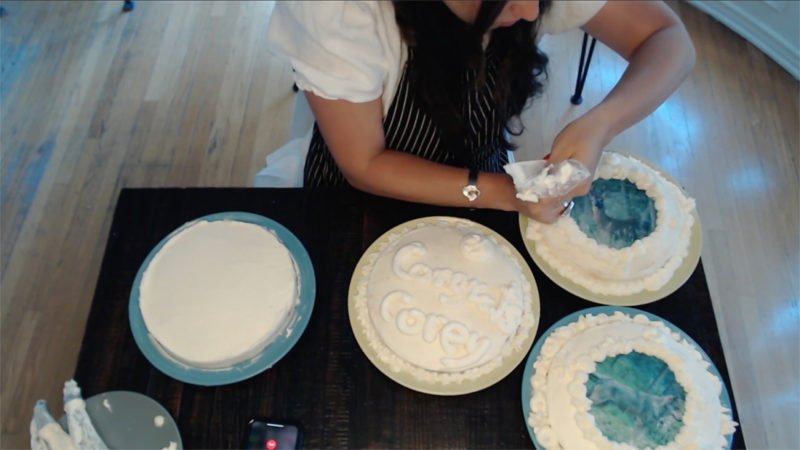
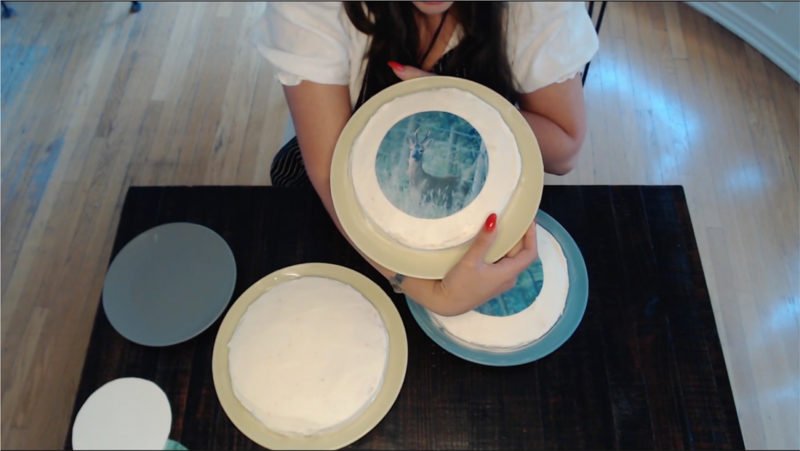
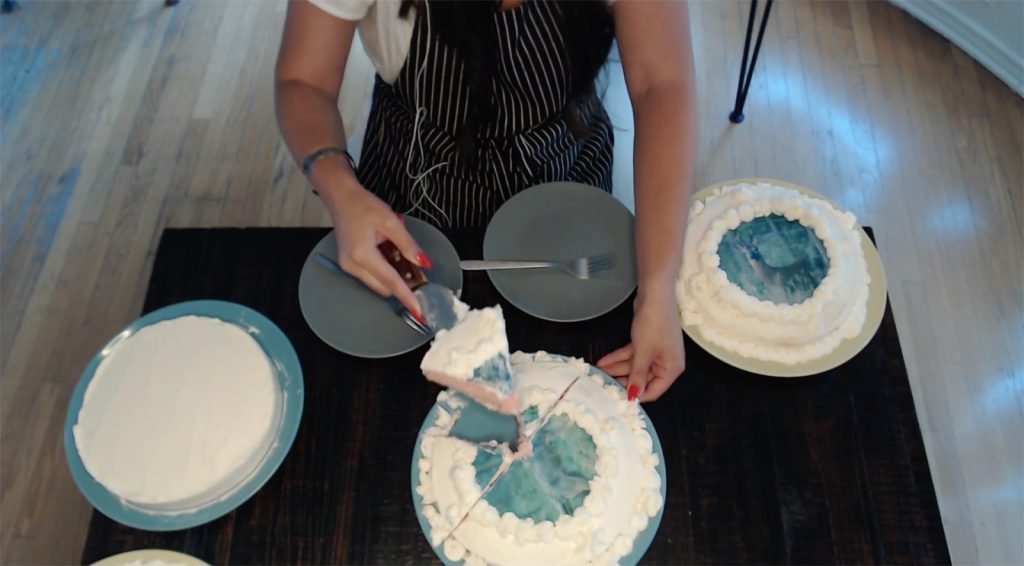
Sharing cakes at funeral wakes is a very common practice common amongst the Lakota people and other Turtle Island communities; often these cakes have an image of the deceased imprinted in the frosting. Danie Koskan writes, “The bereaved are expected to feed anyone who comes to call, and often it’s a steady stream of people paying their respects. Feeding so many people can get expensive, so some families choose to limit the wake to one night.” Lakota ceremonies for death not only purify the soul of the deceased but help to heal relatives and community members.
This cake series is the beginning of what will be a long term sculptural and performative practice where Kite will make edible and inedible funerary cakes. This practice began at the Toronto Biennial in collaboration with Althea Thauberger, where the artists mourned the death of the conch shells used in the performance by feeding the audience members cakes. For this live stream, Kite will mourn the death of the English Wolf, now extinct, and Roe Deer, which was near extinction 300 years ago. This first cake draws on Phil Deloria’s book Playing Indian, which discusses how fights for hunting rights in Great Britain led to English settlers dressing up as Indians during the American Revolution and beyond, shaping the American identity. Other cakes will be in mourning of extracted metals used when creating Artificial Intelligence, the future deaths of cancer victims as a result of Uranium mining beginning in South Dakota, and the deaths of loved ones we prepare ourselves to mourn for in the coming weeks, years, and decades.
2021
These works are part of the artist’s ongoing performance and sculpture series that considers protocols for mourning to process the death of human and non-human beings. Often imprinted with an image of the deceased, such cakes are commonly shared at funeral wakes in Lakota and other Turtle Island communities. Lakota ceremonies for death purify the soul of the deceased and help to heal relatives and community members.
The images on these cakes reference the environmental and human impacts of uranium mining. Operated by a Crown Corporation of the Canadian government from 1953 to 1982, the Beaverlodge uranium mine’s activities resulted in the contamination of a number of watersheds in the Uranium City area of northern Saskatchewan. Radionuclides such as uranium, radium, lead and polonium accumulate in lichens eaten by caribou. As it moves up the food chain, radioactivity will concentrate, threatening the food security and health of those who rely upon the caribou for sustenance.
The presence of uranium mining has been ubiquitous throughout Indigenous territories such as the Dene and Inuit in Canada as well as the Dine (Navajo) and Lakota in the United States, among many others. In mourning the impacts of this industry, Kite also draws attention to the continued resistance against it as a path to healing in itself.
2023
Sharing cakes at funeral wakes is a practice common amongst the Lakȟóta people; often, these cakes have an image of the deceased imprinted in the frosting. Kite, an Oglála Lakȟóta performance artist and composer, explores this tradition in a performance in which she decorates funerary cakes made from local indigenous ingredients while speaking with friends, relatives, and elders about traditions, kin, land, and species they have lost. As we face death in the world, Kite hopes to turn towards protocols for mourning to process the death of beings, human and non-human. Cake and coffee will be served.
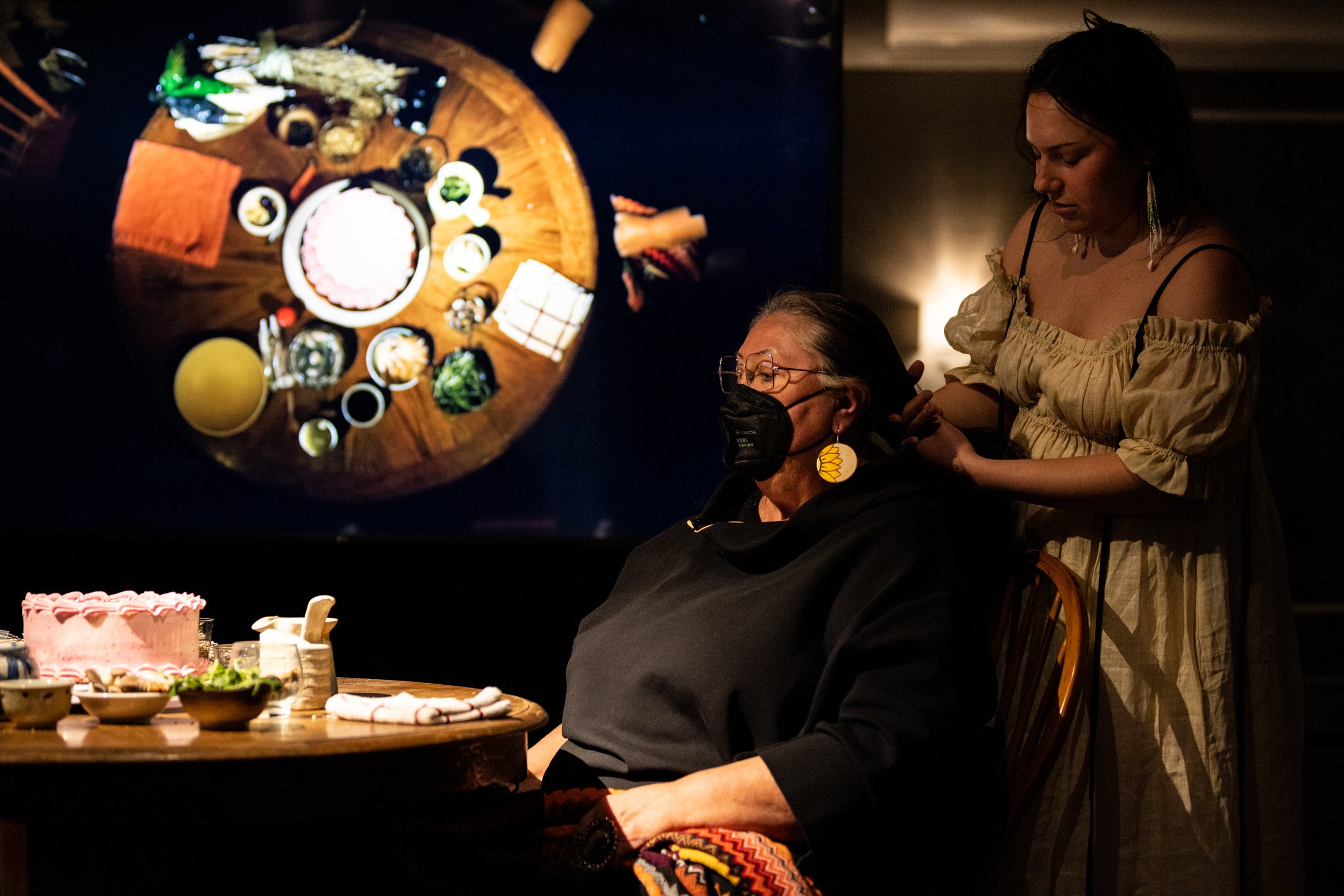
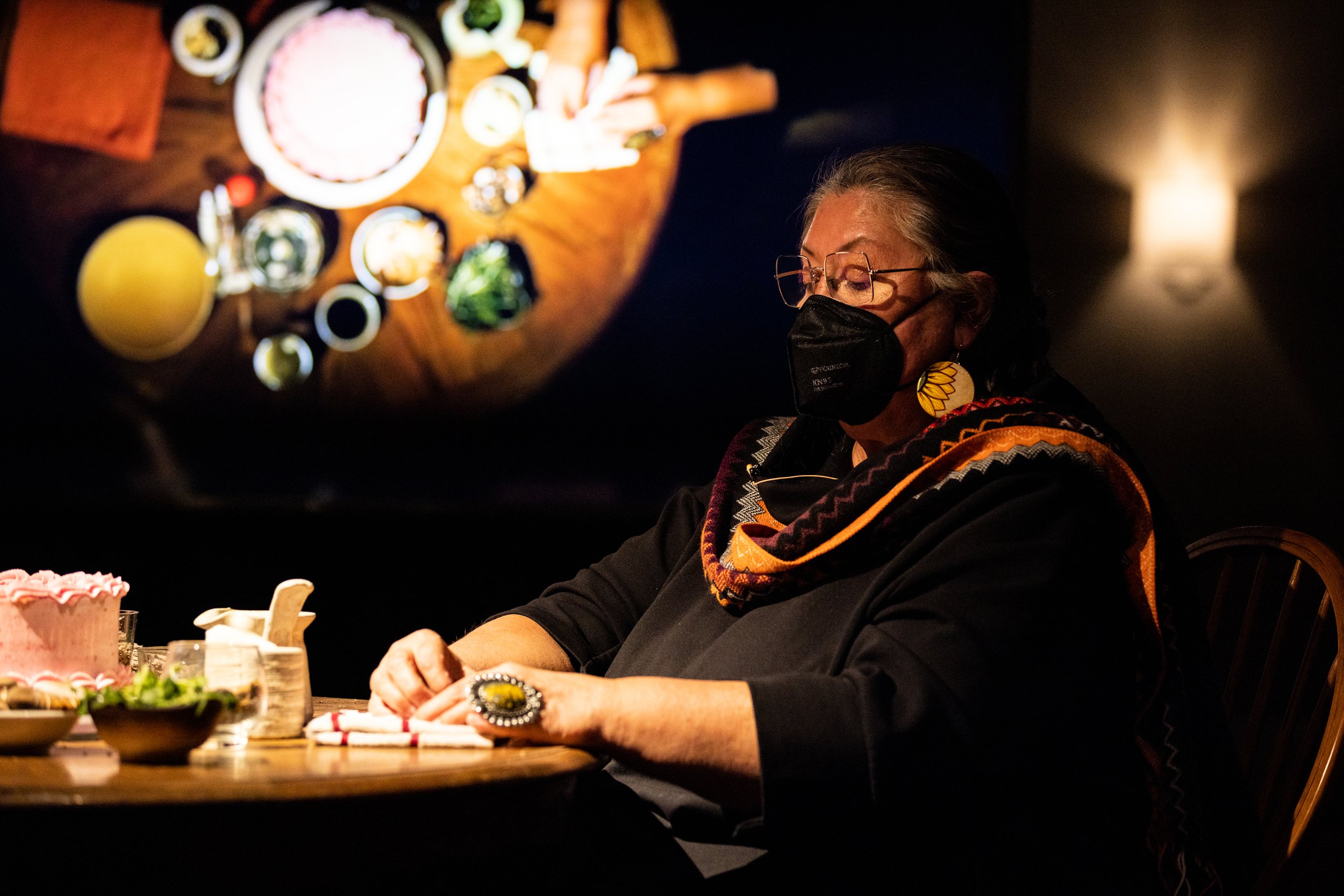
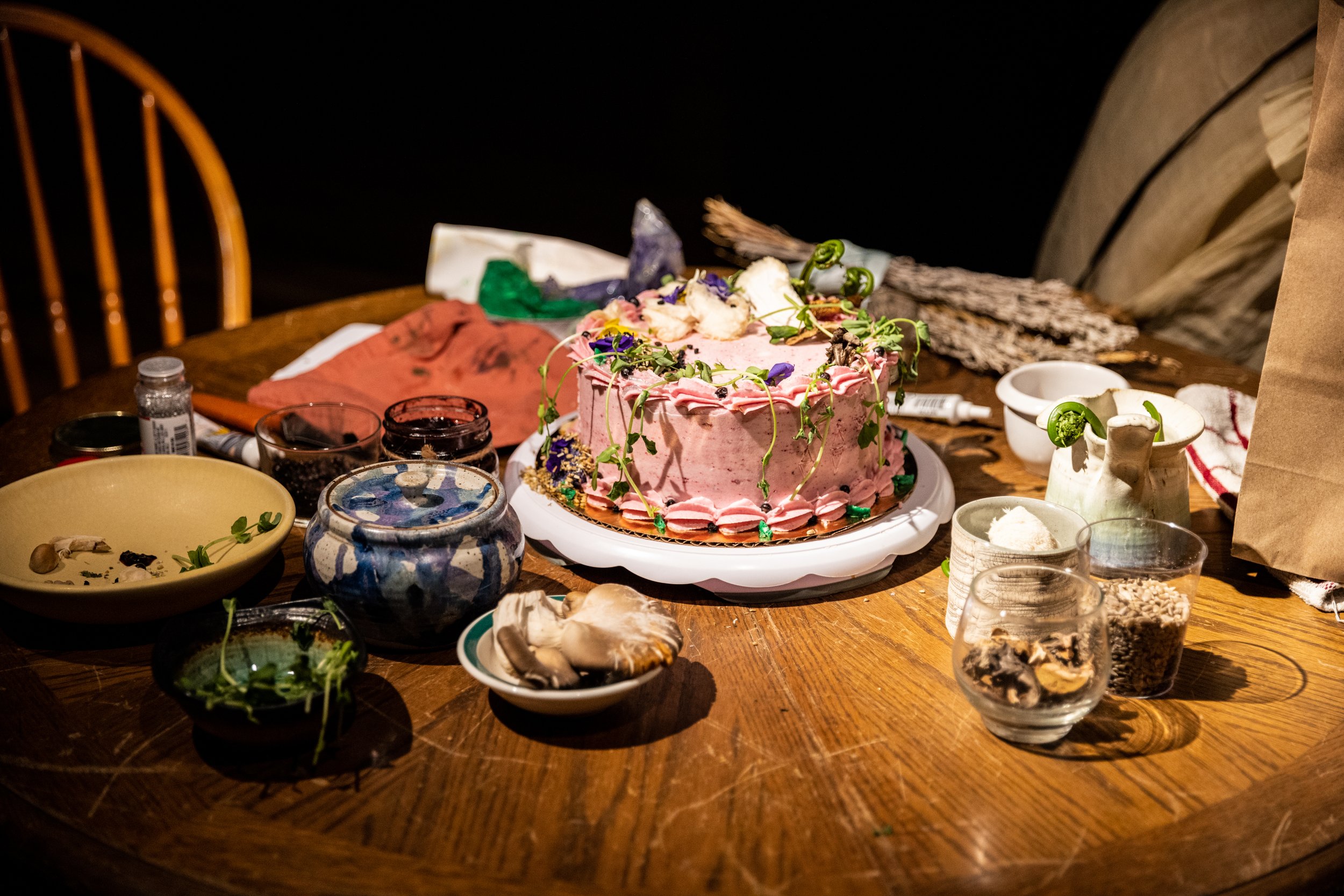
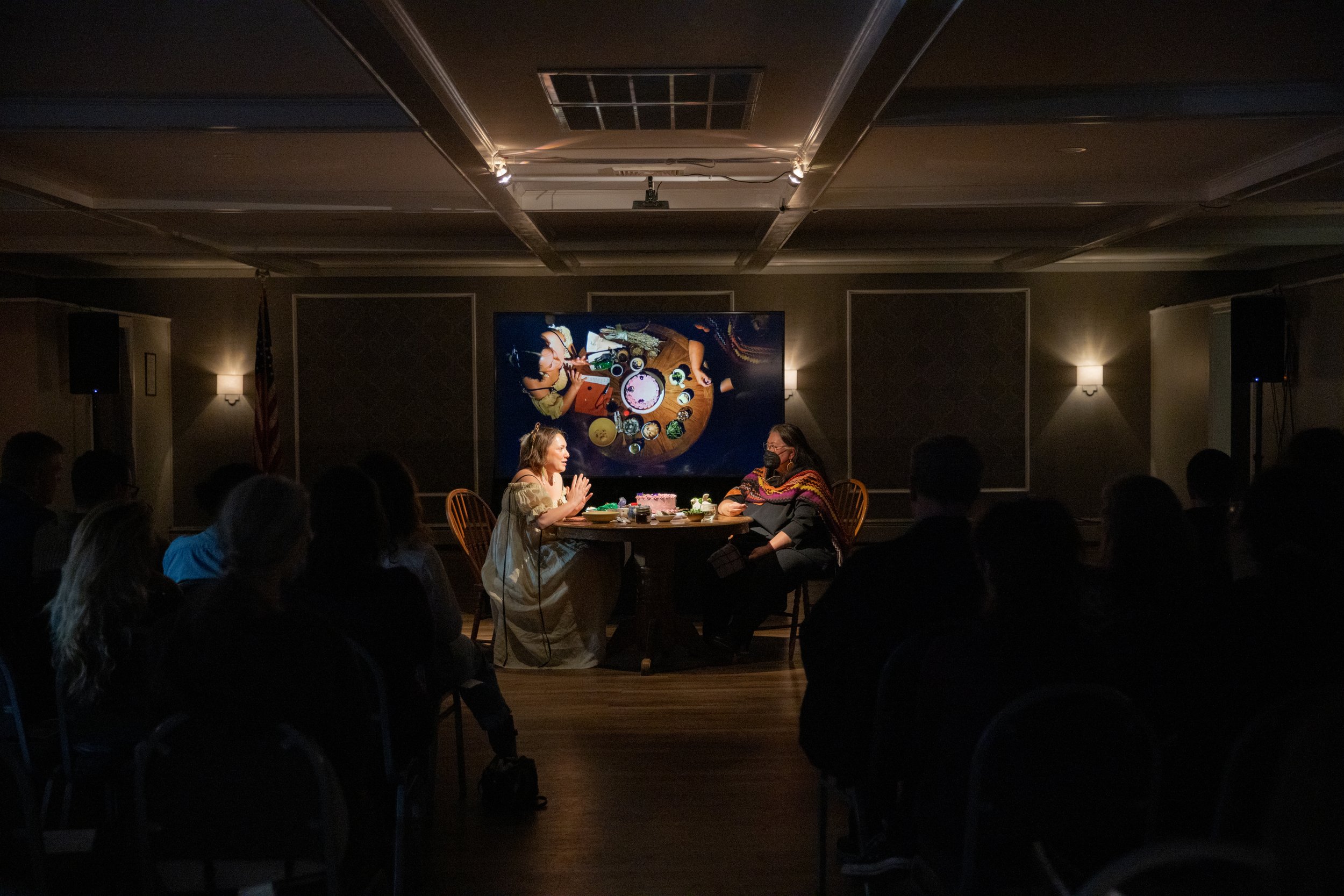
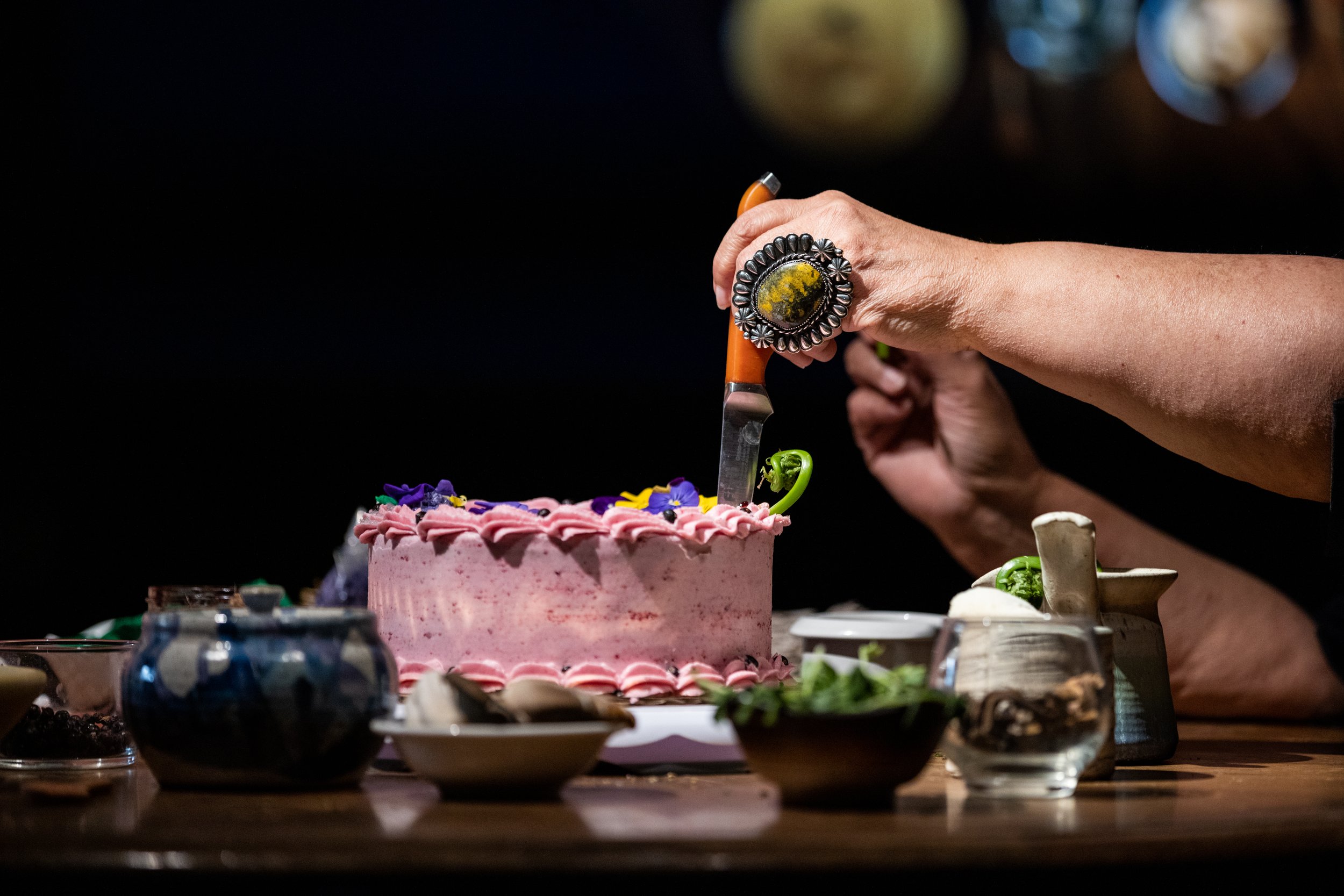
Guests
May 4 • Corey Stover
May 5 • Lou Cornum
May 6 • Jolene K. Rickard
May 7 • Alisha Wormsley
Artists & Creative Team
Kite Lead Artist
Bradley Dry Recipe Creation
Sweet Maresa’s Baker
Laura Hirschberg Production Stage Manager
In the Realm of Miracles, 2022
In this exhibition, Kite’s body of artwork focuses on settlers’ desire for Indigeneity through disturbed relationships to hunting nonhumans. How are relationships to the land formed without understandings of ancient cosmologyscapes? What is the connection between sickness of the land and sickness of the soul? Kite’s found sculpture, Iyátakunipi kte šni (they will come to nothing), a poorly made taxidermy reveals the mundane horror of human relationships to deer. Ȟuŋwíŋ áyapi is a hide sculpture with beaded forms of rot and decay. Finally, Deerfucker is a video created with various machine learning techniques examining text and images where settler desire for deer veers into horror.
Thank you to Sam Lee Regan
Artworks
Sculpture
Iyátakunipi kte šni (they will come to nothing), Kite, 2022, Installation with taxidermy deer.
Ȟuŋwíŋ áyapi, Kite, 2022, hide sculpture with beadwork.
Video
Deerfucker, Kite, 2022, video created with machine learning techniques https://vimeo.com/737994313 .
Previous Showings
Kite & Natani Notah: In the Realm of Miracles. 108 Contemporary, Tulsa, Oklahoma. August 5 - September 25, 2022.
Oíhaŋke Waníča (Infinity), 2023
Oíhaŋke Waníča (Infinity), 2023
Embroidery on velvet fabric, performance.
Image credit: Emmanuel Abreu
Performed at CARA NYC
This artwork lives and breathes while Kite sleeps in Ancram, NY. Each week, Kite will create a series of geometric designs that translate her dreams. The patterns draw from traditional Lakȟóta art-making where many designs and forms of bead-work use geometric renderings to communicate narratives and visions which are sometimes first encountered in dreams. Kite’s patterns, rooted in a rich history of creation and subconscious engagement, will then be translated through Lakota designer Sadie Red Wing's Lakota Shape Kit. This work imagines the embroidery machine as an artificial being transforming knowledge from the dream world into the visual language of the dreams and correspond the designs with Lakȟóta words. These cyborgian communications will lead to the production of embroidered textiles depicting the designs, and in turn a series of activating performances. The land of dreams, thus becomes fodder for a dialogue between individuals and a future of communally built cybernetic systems.
Iron Road, 2021
In collaboration with Becky Red Bow and Corey Stover
“In Kite’s installation Iron Road (a collaboration with Corey Stover and Becky Red Bow), a recording of family conversations can be heard. Gentle drone footage of some place I suspect the artist calls home plays on a screen on the floor, prompting me to bow my head slightly as I listen to the audio. A collection of small stones sits a few feet away from the video, carefully arranged into a geometric motif. The audio recounts stories of dreams and stones significant to the artist’s family. Part of the narrative involves Kite’s great-great grandmother escaping the Wounded Knee massacre on foot and finding safety through shared language when another person speaks to her in Lakotah.”
Iron Road, Kite in collaboration with Corey Stover and Becky Red Bow, 2021.
Mixed media installation.
Image by Bronwyn Lutz-Greenhow
Iron Road, in collaboration with Corey Stover and Becky Red Bow, presented at Tinworks Art in 2023. Photo documentation by Ryan Parker
Previous Showings
“Invisible Prairies: Sensing and Sounding the Plains,” Tinworks Art, July 8 - October 14, 2023. Bozeman, Montana.
“When Veins Meet Like Rivers; ᑲᑎᓐᓂᖅ / okhížata / maadawaan.” Plug In ICA, August 21 - December 17, 2021. Winnipeg, Manitoba.
Press/Reviews
Muñoz Gómez, Mariana. “When Veins Meet Like Rivers; ᑲᑎᓐᓂᖅ / okhížata / maadawaan.” Plug In ICA, August 21 - December 17, 2021. Winnipeg, Manitoba. Akimblog Post.
Kerr, Kitty. “The Plurality of Meaning: innovative art exhibit explores the complexities of convergences and divergence.” The Manitoban. October 6, 2021.
Hél čhaŋkú kiŋ ȟpáye (There lies the road), 2021
Description
The Vera List Center for Art and Politics presents Hél čhaŋkú kiŋ ȟpáye (There lies the road), an exhibition and performance by Oglála Lakȟóta artist Suzanne Kite as the culmination of the artist’s year-long research project Wówasukiye waŋží ahóuŋpȟapi kte (There is a rule that we must observe). Produced at the invitation of the Vera List Center—as part of its 2020–2022 As for Protocols focus theme—, the project considers how artworks using artificial intelligence can be created ethically by developing and applying protocols that are based on Lakȟóta ontologies.
For this site-specific installation, Kite and a team of collaborators have developed a body interface that incorporates movement, performance, carbon fiber and stone sculptures, and graphics into an immersive audio-visual environment. Together the works invite us to reconsider our current and future relationships to nonhumans, especially to technology and artificial intelligence, and strive to establish a sense of relationality between gallery visitors and the computer as a nonhuman entity.
In Lakȟóta ontologies, materials such as metals, rocks, and minerals are capable of both volition and kinship with human beings. From this perspective, Kite creates new spaces for encounters with artificial intelligence, forming innovative methodologies for approaching human and nonhuman relations in a Good Way (an ethical way). This approach calls for a rethinking of the ontological status of each element that composes and creates artificial intelligence, from the earth’s resources mined for technology to the artworks that eventually use them. By bringing Indigenous epistemologies to bear on questions of AI, Kite’s work as a scholar and an artist develops conceptual frameworks and protocols by which we can conceive of expanded relationships with nonhuman computational technology and AI and make room for them in our collective future.
The exhibition is accompanied by a newly commissioned essay by Riel Bellow on the VLC’s online publishing platform and a sound work by Kite, which is also included in the exhibition. Additionally, documentation of a May 2021 conversation between Kite and artistic and research collaborators Scott Benesiinaabandan (Anishinaabe), Clementine Bordeaux (Sičáŋǧu Oglála Lakȟóta), and Jason Edward Lewis (Hawaiian and Samoan) is also available on VLC’s web site. Entitled Hél čhaŋkú kiŋ ȟpáye (There lies the road) – A Dialogue About Making Art in a Good Way, it was presented by the VLC as part of this year-long project.
Artworks
Hél čhaŋkú kiŋ ȟpáye (There lies the road), performance, 2021. Link
Hél čhaŋkú kiŋ ȟpáye (There lies the road), Immersive Installation, 2021.
Hél čhaŋkú kiŋ ȟpáye (There lies the road) – A Dialogue About Making Art in a Good Way, online conversation with Scott Benesiinaabandan (Anishinaabe), Clementine Bordeaux (Sičáŋǧu Oglála Lakȟóta), and Jason Edward Lewis (Hawaiian and Samoan). Part of As for Protocols Seminar Series, May 20, 2021. Link
Okáletkehaŋ (Branching), 2021, Kite in collaboration with Santee Witt, Video (color, sound), 10:17
Wóolowaŋ wakáǧe. (I composed this music.), 2021, Stones, dimension variable.
Okáwiŋǧaŋpi (circling), Kite and Bobby Joe Smith III, 2021, digital graphic.
Imákȟaheye (Method), Kite and Bobby Joe Smith III, 2021, Applied Phototex, 72”x72".
Methodology Diagrams:
Wičháȟpi, íŋyaŋ, thiyúktaŋ (stars, stones, dome framework)
Kapemni (twisting vortex)
Wičháȟpi, íŋyaŋ (stars, stones)
Okáwiŋǧaŋpi (circling)
Thiyúktaŋ (dome framework)
Oáli (ladder)
Kapemni (twisting vortex
Photos at PS122 by Argenis Apolinario
Imákȟaheye (Method), Kite and Bobby Joe Smith III, 2021, Acrylic on glass, FOFA Gallery at Concordia University,Montréal, QC.
Previous Showings
“Hél čhaŋkú kiŋ ȟpáye (There lies the road),” PS122 Gallery, in partnership with the Vera List Center. New York, NY. December 4 - 12, 2021.
“Hél čhaŋkú kiŋ ȟpáye (There lies the road),” Concordia Graduate Exhibition, FOFA Gallery, Montréal, QC. June - November 2023.
Press/Reviews
Will Willbur, “Artist Suzanne Kite Debuts New Show in Partnership with the Vera List Center for Art and Politics,” New School News, December 13, 2021. Link
Wóaič’ibleze (Self-Reflection), 2023
Description
“Prayed to by Lakota midwives, To Win ‘Blue Woman’ is a spirit who inhabits around the hole in the Big Dipper. To Win (or Ton Win, ‘birth woman’) is called on to aid women in labor, easing the pain of childbirth. ‘Blue Woman’ also assists the spirits of newly deceased humans in being born back through the hole into the spirit world.” - Goodman, Lakota Star Knowledge
Artworks
Wóaič’ibleze (Self-Reflection), 2023
Video, installation
Duration: 1:20 min. (looped)
Previous Showings
“ArtNow: The Soul is a Wanderer,” Oklahoma Contemporary Arts Center, June 22, 2023 - January 15, 2024.
Tȟaŋmáhel, 2022
Description
Kite composes a ‘visual score’ – a form of experimental music notation – entailing symbolic forms that performers and musicians can read and interpret. Deriving ideologies from traditional Lakȟóta artmaking, as seen in their quillwork and beadwork, these processes of visual score-reading are reflected in their geometric designs and translated from the aftermath of a waking or sleeping dream. Similarly to reading and writing music, these designs communicate concepts without verbal language, becoming a semiotic language, a language of symbols that do not have to be explained. Like stories, their meaning changes over time and develops over a lifetime, no longer confined to its original interpretation. Creating a dream narrative from a collection of visions re-enacted through videos, the performance, Tȟaŋmáhel, will assign visions to symbols and weave a complete graphic score into being.
Artworks
Kite, Tȟaŋmáhel, 2022, experimental lecture and performance, including visual score and experimental music notation.
Previous Showings
“Skill Futures - Tȟaŋmáhel”, Live Lecture and Performance online, Singapore Art Museum, September 28, 2022.
“Art Now: The Soul is a Wanderer,” Oklahoma Contemporary Arts Center, performance, September 28, 2023.
Oíhaŋbleta (In a Dream), 2023
Mnišma wakignúŋke 3, Kite, 2023. Deer hide, conductive thread, glass beads, dreams (52 in x 26 in)
Description
Oíhaŋbleta (In a Dream) is an exhibition of leather wall hangings and a sound piece by the Oglála Lakȟóta artist Kite (aka Dr. Suzanne Kite). Drawing on her doctoral research into the ethics of artificial intelligence (AI), Indigenous methodologies, and Lakȟóta ontology, Kite translates fragments of her dreams into Lakȟóta geometries that she embroiders onto deer hides sourced from the Laurentian mountains. Rendered in sparkling beadwork and non-electrified conductive thread, the compositions contribute to a Lakȟóta visual language that allows multiple meanings to orbit around core semiotic associations. The hides also function as “tactile music scores” in dialog with a corresponding sound piece that similarly seeks to bring knowledge from the nonhuman realms of machines, animals, and spirits into the human realm of creation.
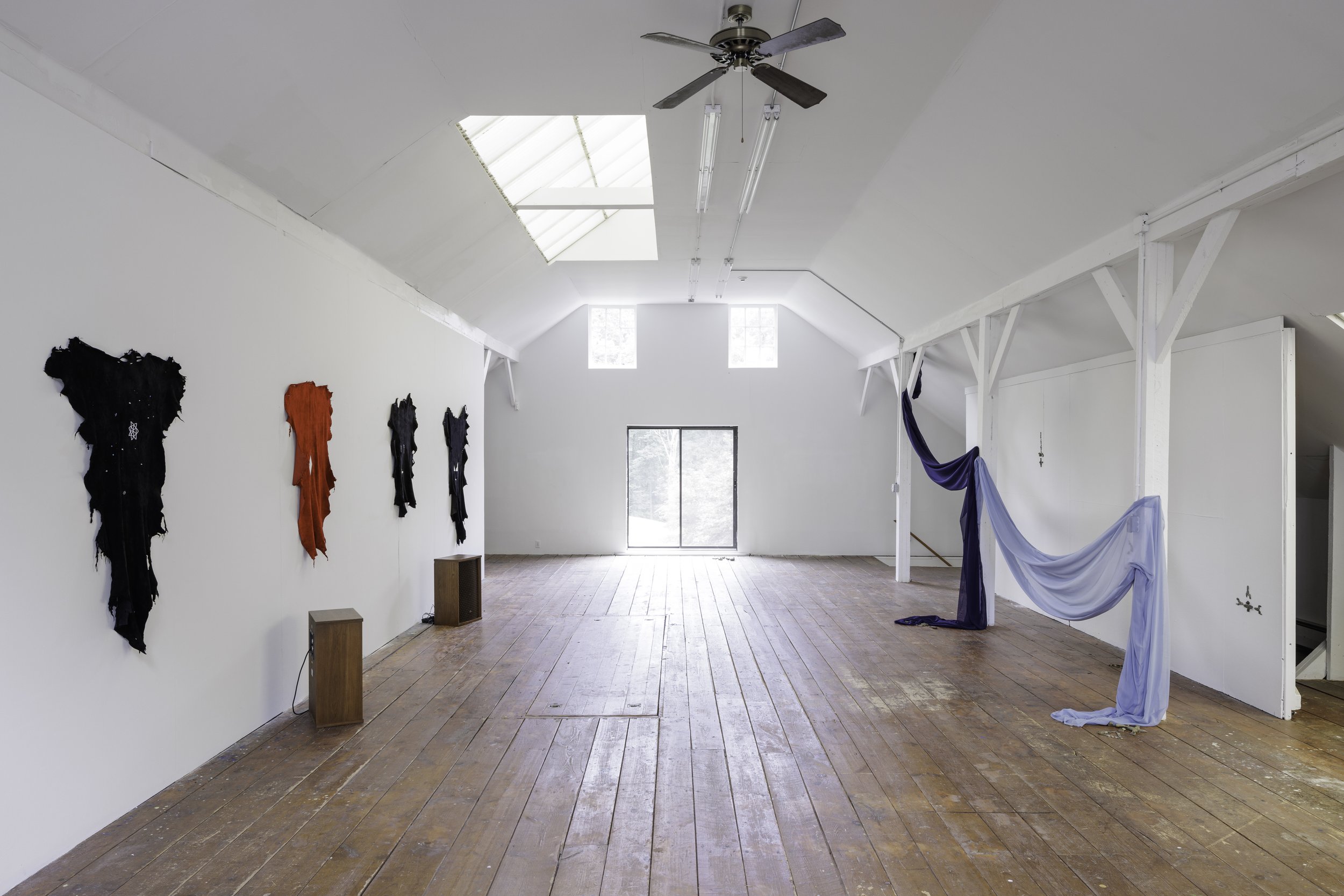


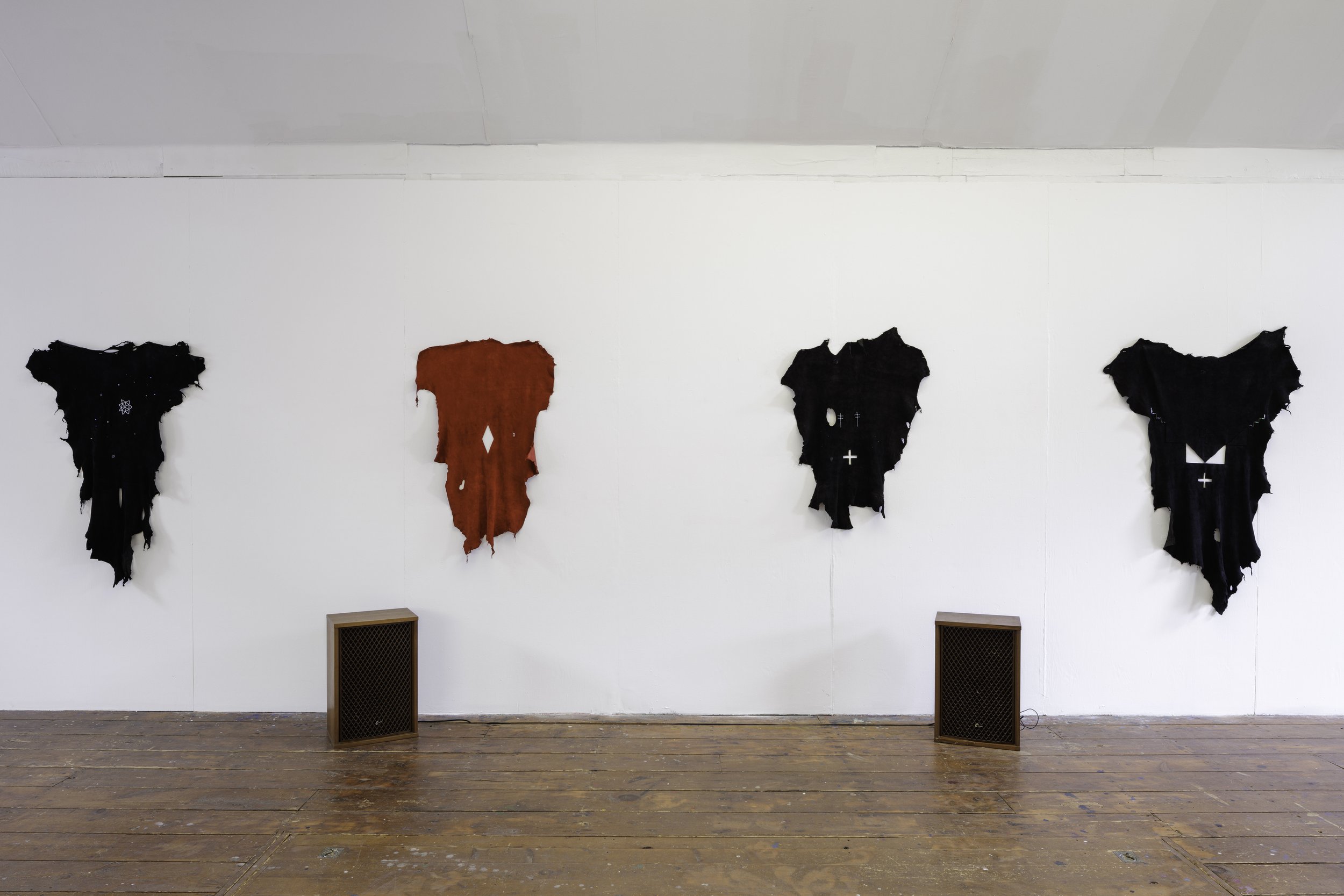
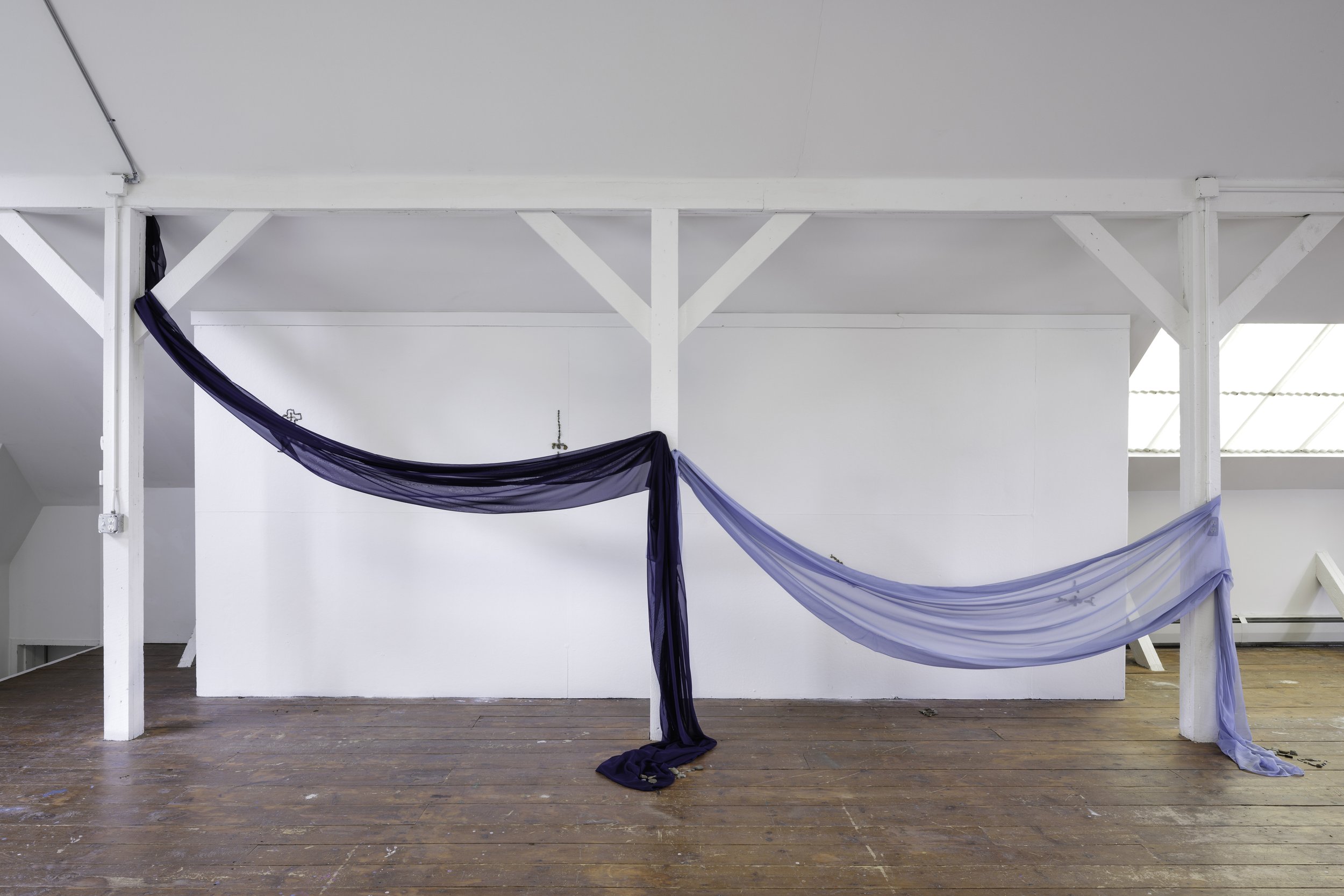
Documentation
Photo credit Alon Koppel. Courtesy River Valley Arts Collective.
Artworks
Mnišma wakignúŋke 1 - 4, Kite, 2023, Deer hide, conductive thread, glass beads, dreams (52 in x 26 in each)
Mnišma wakignúŋke (score realization), Kite, 2023, Audio (12 minutes)
Previous Showings
Kite: Oíhaŋbleta (In a Dream), River Valley Arts Collective, presented at the Al Held Foundation in Boiceville, New York. June 25 - October 15, 2023. Link
These artworks were created during Kite’s residency at the Stoneleaf Retreat in Eddyville, New York.
Ínyan Iyé (Telling Rock), 2019
ÍŊYAŊ IYÉ (TELLING ROCK), KITE, DEVIN RONNEBERG, 2019. TRANSLATION BY ALEX FIRETHUNDER.
SONG, POWER, SOUND, PROCESSORS, MACHINE LEARNING DECISIONS, HANDMADE CIRCUITRY, GOLD, SILVER, COPPER, ALUMINUM, SILICON, FIBERGLASS
As Ínyan Iyé speaks, listeners may respond to it by bending and moving its braids, affecting the sounds. This sculpture interrogates the relationships between human and non-human entities and intelligences. Through Oglala Lakota ontologies, even materials such as metals, rocks, and minerals can communicate of their own volition. By considering the 'hearing' and 'listening' capabilities of nonhuman entities, a method of engagement reliant upon mutual respect and responsibility becomes possible. Íŋyaŋ Iyé speaks, you respond to it by bending and moving its braids, effecting the sounds it makes. Íŋyaŋ Iyé listens to the changes in its own voice and generates a response in lights and sound.
People listen close, I whisper
People listen close, I whisper
The rock speaks beyond hearing
People listen close, I whisper
Hear me, I have something to say
Hear me, I have something to say
Only to those who listen
Hear me, I have something to say
Many nations speaking
Many nations speaking
We speak to each other without words
Many nations speaking
I am always speaking
I am always speaking
You watch but hear nothing
I am always speaking
Oyáte, taŋyáŋ anáǧoptaŋ po! Očhížipi.
Oyáte, taŋyáŋ anáǧoptaŋ po!
Očhížipi. Íŋyaŋ iyé kiŋ naȟ’úŋ-phiča šni.
Oyáte, taŋyáŋ anáǧoptaŋ po! Očhížipi.
Táku waŋ epȟíŋ kta čha namáȟ’uŋ po!
Táku waŋ epȟíŋ kta čha namáȟ’uŋ po!
Anáǧoptaŋpi kiŋ hená ečéla namáȟ’uŋpi kte.
Táku waŋ epȟíŋ kta čha namáȟ’uŋ po!
Oyáte óta iyápi.
Oyáte óta iyápi.
Wóiye čhóla iyápi.
Oyáte óta iyápi.
Iwáye s’a.
Iwáye s’a.
Waŋlákapi éyaš tákuni nayáȟ’uŋpi šni.
Iwáye s’a.
Image credit to the Bemis Center of Contemporary Arts
Pȟehíŋ kiŋ líla akhíšoke. (Her hair was heavy.) (2019)
Pȟehíŋ kiŋ líla akhíšoke. (Her hair was heavy.) is a work by Oglala Lakȟóta artist, Kite, which builds on her hair-braid interfaces and new research into AI-generated text. The hair-braid interface is a computer on a 50 foot braid of hair. The computer system itself is made of song, power, sound, processors, machine learning decisions, handmade circuitry, gold, silver, copper, aluminum, silicon, and fiberglass. This hair-braid interface is something between instrument and sculpture, built collaboratively over the last decade with James Hurwitz and Devin Ronneberg. On stage, Kite manipulates the braid which controls the sonified, AI-generate texts. Then, the braid’s software listens to those audio changes and uses machine learning to make decisions about how and when to change the projection of hair. During the 8 minute performance, the audience witnesses a sonic sculpture which is a feeble human attempt to listen without the ears but with the body in relation with AI. The computer’s decisions are audible to human ears, sonifying invisible data. Lakȟóta ontology is an already established way of being, where seemingly ‘inanimate’ objects can be alive with spirit, and Pȟehíŋ kiŋ líla akhíšoke. (Her hair was heavy.) is an experiment in greeting that spirit.
Listener, 2018
“This is where Listener begins: with a wanderer Listening, an Oglala woman, equipped with Listening devices, which are passed down from woman to woman. Alone, her devices work in ways she cannot quite understand, they seem to listen farther than technologically possible, beyond time and place. She has a suspicion that she is receiving scrambled transmissions from a good place, but a Far Place. She feels they Listen back.”
Focusing on developing relationships with the computer as a nonhuman entity, Listener is an iterative, site-specific performance artwork which speculates a future through Lakota ontology, narratively and physically manifesting a relationship with metals in electronics, performed via an electronic interface woven into hair (hair is sacred to the Lakota). The sonic landscape includes live police scanners, synthesizers played by the hair, and algorithmically re-arranging poetry with a voice speaking of a future landscape, prophecies, dreams, rumors, and the possibilities in listening. This composition is constructed in a sonic and physical spiral. A projection of growing geometric design, constructed from Lakȟóta womens’ quillwork shapes, acts as a compass for the performer. The artist watches the compass, moves the hair, which effects the synthesizer, the Machine Learning algorithm listens to the synthesizer and decides how to move the compass, and the spiral continues. The future is dangerous, but as my grandfather says, spirits and ancestors are just there on the other side, trying to help. It is our responsibility to listen.
Listener, Performance, Kite, 2018. 15-28 minutes.
Includes floor projections, audio channels, Hair-Braid interface.
15-28 Minutes, has been staged with one project and installed TVs, one projector pointed at the floor, or with 3 floor pointed projectors onto custom screens with 3 isolated audio channels.
Four meters of hair are laid out in a spiral, in this performance, the artist slowly winds into the center, whispering into an earpiece. The spoken voice is algorithmically scrambled, making it torturous to continue reciting as the poetry is forming and reforming.
‘L-Sys’ (Lakota System), Kite, 2018.
This growing and changing shape is projected during performance, constructed from shapes traditionally only used and created by Lakota women. The movement and growth of this projection is decided by the computer.
Interface
This four meter braid is woven with rare earth metals, sound electronics, sacred plants such as sweetgrass and sage, and an accelerometer/radio transmitter package. Imagining Lakota epistemologies in the future, this braid considers that hair is a sacred, extra-sensory part of the body, making it the logical non-human sonic appendage.
This animation accompanies the performance and is created at each performance location. It is a 3D rendering of the area surrounding the performance, rendered as an exploration of the digital space. The 3D model is built from United States Geological Survey data, reflecting the deeply colonial ties of mapping the land to data and computer vision.
Associated Artworks
Listener, Performance, Kite, 2018. 15-28 minutes.
Includes floor projections, audio channels, Hair-Braid interface. Adaptable for any space or online. This work has been staged with one project and installed TVs, one projector pointed at the floor, or with 3 floor pointed projectors onto custom screens with 3 isolated audio channels.
‘L-Sys’ (Lakota System). Video and audio recording. https://vimeo.com/281906974. 17 minutes 26 seconds. Projection from Listener. Screening/Installation.
Documentation of a live performance of Listener, site-specific to Ottawa, Ontario. There are 3 video feeds during the performance, this is the main video feed which shows the machine learning algorithm at work.
Hair-Braid Interface, Kite, 2018. Image
Listener, Cloak, costuming, Kite, 2018.
Listener, Script/Poetry, Kite, 2018.
Installation Version
Low-Fi version for CRT TVs and printed posters. This version is intended for Indigenous, especially Lakota, audiences where the poetry is available for the public.
Screen and Floor projections. Three videos as bubbles on a large screen.
Three convex circles on the floor with projection mapping.
Multi-channel audio installation: 1-4 isolated speaker set ups. In a low tech situation this is routed through locally acquired CRT TVs.
Long cut video installation for cathode-ray tube television.
One channel screening version
Fever Dream, 2021
Description
Fever Dream, Kite and Devin Ronneberg, 2021. Interactive multimedia installation (television, projector, LIDAR detector, digital video).
Fever Dream is an interactive multimedia installation by Devin Ronneberg, a multidisciplinary artist of Kanaka Maoli/Okinawan descent working primarily in sculpture, sound, image-making, and computational media, and Kite, an Oglala Lakota performance artist, visual artist, and composer. The work brings together their mutual interests in the implications of emergent technologies and artificial intelligence, information control and collection, Indigenous ontologies, and bodily interfaces. In response to the audience’s proximity, a CRT TV flips between channels algorithmically tuned in to scraped footage of conspiracy theories, paranormal and extraterrestrial sightings, and recent news broadcasts. The work plumbs the depths of the settler colonial psyche and the ways in which settler conspiracies are often founded on a denial of Indigenous agency and futurity, such as “ancient aliens” being responsible for the building of Indigenous earthworks and monuments. The work and its library of rotating footage function as a conspiracy generator for settler futurity, reliant on dispossession and the colonial cover-up. UFO sightings, space cults, and military-science Youtube theorists intermingle with press briefings on the oppression of “illegal aliens” (the dismissal of migrant rights at the border), uranium mining on Indigenous territory, and nuclear paranoia. GPT-2 generated subtitles, also built from a curated library, draw the viewer in, encouraging us to overcome colonial biases by first breaking through embedded conspiracies, mythologies, and desires.
Previous Showings
“Speculations on the InfraRed,” Elizabeth Foundation for the Arts (EFA), January 30–March 6, 2021, New York, NY.
“COUSIN Collective Presents Cycle ∞,” as part of MoMA’s Doc Fortnight 2021. March 27, 2021, 12:00 p.m.– April 1,2021, 12:00 p.m. New York, NY (Online)
“Exhibition | AI Delivered: The Abject,” Chronus Art Center, July 3 – October 17, 2021, Moganshan RD., Shanghai.
“Land Back,” La biennale d’art contemporain autochtone (BACA) – 6ème édition, Quai 5160 – Maison de la culture de Verdun, May 7 - July 3, 2022. Montréal, QC, Canada.
Press/Reviews
Ian Bourland, “Countering the Fetishization of Indigenous Art,” Frieze Magazine, March 15, 2021, https://www.frieze.com/article/countering-festishization-indigenous-art .
Harry Burke, “Speculations on the Infrared,” Art Agenda Reviews, March 18, 2021, https://www.art-agenda.com/features/383425/speculations-on-the-infrared .
Clément Gaboury, “Art autochtone à Verdun: se tourner vers le futur,” Journal Métro, May 13, 2022, https://journalmetro.com/local/ids-verdun/2824404/art-autochtone-verdun-futur/.
Valérius, “Invitation à découvrir l’art autochtone contemporain avec Land Back à Verdun,” Nouvelles d’içi, May 10, 2022, https://nouvellesdici.com/actu/land-back-biennale-art-autochtone-contemporain-land-back-verdun-quai5160-montreal/?fbclid=IwAR3t1NPzEsy9DqfgZNPPo3LfeSHAW-JX7qRv1hhW7IeZhEj1DRavyKS2tOs
Jérôme Delgado, “Luttes de guérison à la Biennale d’art contemporain autochtone,” Le devoir, May 21, 2022,
Mázaȟlaȟla uŋ lowáŋpi wayáka wakȟáŋheža. (Enslaved children now sing through the bells.)
Description
Kite, in collaboration with Tongva/Ajachmem artist, writer and tribal activist L Frank and American artist and writer, Kristopher Rindon Johnson, will be contributing an artwork for the Lifes Exhibition at the Hammer Museum in Los Angeles, California.
Wičhóoyake kiŋ lé mičhúwe kiŋ omákiyake. (This story was told to me by my older sister.) is comprised of Lakota ideograms telling the story of gift giving, transformation, and rejection. The artwork forms part of a collaboration between Kite, Tongva/Ajachmem artist, writer and tribal activist L Frank and American artist and writer, Kristopher Rindon Johnson, and presented at the Hammer Museum in February 2022. The sculpture sits on a wall next to Johnson’s live stream of Catalina Island and across the room from an L Frank painting. In the courtyard in the Hammer Museum, the bell tower rings every 15 minutes, just as it does on the Island, except the bells are forced to play iterations of L Frank’s song. The song is scrambled when the show opens and iterates towards the original version everyday for 71 days.
Collaboration begins with a text by Johnson based on his childhood experiences on Pimuu (Catalina Island). Johnson reached out to Kite, who also had childhood memories of Pimuu, and Kite and Johnson connected with L Frank. This collaboration became a series of gifts given between each artist. The first gift was a blanket for L Frank, the second gift was a song from L Frank to Johnson and Kite. This song, sung in Ataaxum, liuseño, was created by children who were enslaved at the California Missions about their hope for escape and freedom. L Frank gifted this song to Johnson and Kite at her home and the song was transcribed by Kite to be performed on the bell tower on Catalina Island. The third gift were stones for L Frank’s sculptural practice, given by Kite and Johnson. This gift exchange was extended to the company that owns Catalina Island, but they chose not to accept. This gift exchange was extended to UCLA Botanical Garden and they chose not to accept. This gift exchange was rejected by various parties along the way. This collaboration, like most collaborations between Indigenous people and colonial institutions, is shaped by failure and this body of work consists of a lot of unseen labor and unseen gifts. Especially a large piece of soapstone, which never made it into the hands of the Tongvan artist, where it belongs.
The result of this process of gift giving is Kite’s stone sculpture in the Lifes show, comprised of Lakota ideograms telling the story of gift giving, transformation, and rejection. The sculpture sits on a wall next to Johnson’s live stream of Catalina Island and across the room from an L Frank painting. In the courtyard in the Hammer Museum, the bell tower rings every 15 minutes, just as it does on the Island, except the bells are forced to play iterations of L Frank’s song. The song is scrambled when the show opens and iterates towards the original version everyday for 71 days.
Artworks
Audio Piece
Mázaȟlaȟla uŋ lowáŋpi wayáka wakȟáŋheža. (Enslaved children now sing through the bells.), Kite, Audio composition. Duration: 71 days, every 15 minutes.
Sculpture
Wičhóoyake kiŋ lé mičhúwe kiŋ omákiyake. (This story was told to me by my older sister.), Kite, 2022, Texas limestone, Lakota semiotic language, a story, 13 feet x 13 feet.
Previous Showings
Lifes Exhibition, February 16 - May 8, Hammer Museum, Los Angeles
Everything I Say is True, 2017
Description:
Everything I Say is True, performance, Kite, 2017, 30 minutes. Carbon fiber, dress, video, sound, commissioned by Walter Phillips Gallery, Banff Centre.
Everything I Say is True is a site-specific performance and installation project commissioned by the Walter Phillips Gallery. In performance Kite constructs a complex conspiratorial narrative composed with the structure of her grandfather's teachings. Through the use of family and historical documents as well as through a body of work in various mediums, using tactics of manipulation structured upon her grandfather's sweat lodge ceremony as a powerful form, but instead populated with outright lies about time, relationships between Uranium mining and Standing Rock protests, US government conspiracies, claims about Lakota linguistics, and the audience’s vigorous belief in Western physics. This piece attempts to force belief upon an audience by conflating Indigenous magic with coin tricks, tricking people into believing things they don’t believe. Everything I Say is True interrogates the tension between ‘belief’ and ‘truth’ while making a case for the concept of a ‘responsible truth.’
This piece was commissioned by the Walter Phillips Gallery at the Banff Centre for Arts and Creativity and was curated by Jacqueline Bell.
Previews Showings:
Walter Phillips Gallery, BANFF Center, March 29 – May 10, 2017. Banff Performance Video; 29:39min
PŌULIULI (FĀ‘ALIGA): Suzanne Kite - Indigenous Listening, West Space Melbourne, Part of Yirramboi Festival x Liquid Architecture x Midsumma Festival x West Space, May 6, 2017.
OBX Labs: Indigenous Futures Cluster Presents Suzanne Kite, 26 October 2017. Concordia University, Montreal. OBX Labs Video; 31:44min
Philbrook Museum of Art, 2018.
Vancouver New Music Festival, Annex Theatre, October 17-19, 2019. VNM Performance (2019); 30:48min
Squeaky Wheel Film & Media Center, November 22- December 21, 2019
Dress presented at Broadway Gallery, presented by the Soft Network, December 1, 2021. New York, NY.
Reviews and Press:
Erin Sutherland. “10 Indigenous Artists Forging Community Ties.” Canadian Art, Summer 2017: Kinship Issue. 19 June 2017. https://canadianart.ca/features/spotlight-constellations-of-kin/
Natasha Chaykowski. “In Focus: “Everything I Say Is True.” ” BlackFlash, 34.3. 2017.
Winyan Yamni: Three Dreams, 2021
Winyan Yamni: Three Dreams, Kite. Film, 13:52 minutes.
Synopsis
An investigation of a possible Lakota filmic gaze, based on the dreaming methodologies of the Double Woman. The Double Woman or Winyan Nunpa design refers to a mythic and supernatural figure that inspires bead workers through dreams.
Credits:
Director/writer: KITE
Producer: Blackhorse Lowe
Producer: Buffalo Nickel Creative
Producer: Adam Piron / COUSIN Collective
Associate Producer: Jason Edward Lewis / Aboriginal Territories in Cyberspace
Associate Producer: James Hurwitz / Interstellar Art Foundation
Producer/UPS: Dylan Brodie
1st AD: Steve Hanan
Set PA: Justine Rusk
Set PA: Mitch Gilliam
Set PA: Claire Flanary
Set PA: Julie Madalone
Wrap PA: Margaret Cole
Editor: D.E. Hyde
Director of Photography: Charles Elmore
1st AC: Marissa Shoemaker
2nd AC: Brit Hensel
DIT: Loren Waters
Camara Utility: Brittany Bendabout
Gaffer: Sunrise Tippeconnie
Key Grip - 11/6: Micah Hart
Key Grip - 11/7: Jeremy Smart
Production Designer/ Set: Chris Frey / Jake Basnett
Decorator: Cheyenne Scarborough
Asst Set Decorator: Lisa Boudreau
Costume Designer: Shanna Paddock
Still Photographer: Brittany Bendabout
SOUND
Micer: Nathan Young / Mateo Galindo
Audio Engineer: Tom Ryan / Parabolic
MUSIC
Composer/Performer: Kite
Audio Engineer: Robbie Wing
Animation: Devin Ronneberg
Horse Trainer: Katy Bias
Caterer: Bradley Dry
Special Thanks:
Bettina Pérez
Robbie Wing
Bella Rose
Cult Love House
Ryan RedCorn
Joe Brown Thunder
Sterlin Harjo
Tom & Susie Warren
Tate Steinsiek
Tulsa FMAC
Circle Cinema
Tulsa School of Arts and Sciences
Pantheon Digital
Tanner Scarborough
asinnajaq








